




Time is running out to nominate them for the 2026 Kentucky Cattlemen's Association Hall of Fame.

The Kentucky Cattlemen’s Association Hall of Fame is designed to honor a member of the organization that has given time, service, and talent to the betterment of the Cattlemen’s Association at the county and/or state levels. 2025 applications must be postmarked by June 30th.
Call us at (859) 278-0899 with questions.
Application available at www.kycattle.org/hall-of-fame

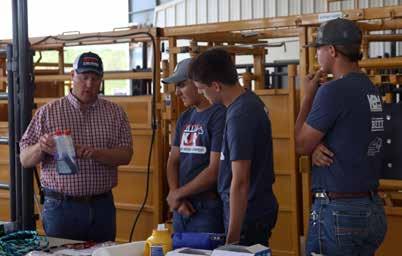





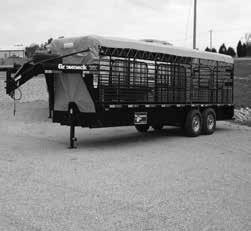











“Too Much Fun” is a 1996 song by Daryle Singletary. If you listen to classic country radio stations, it doesn’t take long for that song to appear in the rotation. The song begins with a police officer telling the artist he was pulled over for having “too much fun” because he had “fourteen people in the back of this truck.” Mr. Singletary proceeds to tell us in the chorus that there is no such thing as having too much fun. It would be like having “too much money” or a “girl too pretty with too much class.” He also tells the listener that you can’t be too lucky or have a car that’s too fast. While the song is a humorous tune about relatively innocent adolescent trouble-making, he brings up the point that too much of a good thing isn’t really that big of a problem.
If Mr. Singletary were a cattleman, he might apply his 1996 hit to a few traits. While single trait selection of any trait does come at a significant cost, physiologically, I would be hard pressed to find an argument that increased marbling, foot structure, udder structure, hair shedding, and fertility come to a detriment to other traits. Yes, intensive selection for increased marbling has often come at the sacrifice of fertility and structure because it has been single-trait selected. While genetic trends exist within a population, nothing physiologically suggests marbling is antagonistic to other traits. Similarly, a cow having better feet and a better udder doesn’t hurt her anywhere else. In fact, there is no such thing as too much of any of these traits I listed above, whereas something like growth is antagonistic to mature size and birthweight. Daryle might hum a tune that a cow can’t have too much marbling, with feet to sound, an udder to good, that is too slick (in the southeast) or too fertile. As much as I tout the superiority of our philosophy when breeding cattle, if you are using bulls of known genetic value (registered bulls with genomic enhanced EPDs), you should produce a marketable calf crop at the sale barn. As always, the devil is in the details. I have spent a decent amount of my time recently working on some long-range planning in the beef industry. One area that leads off nearly every session has been that quality is key, and we can’t give up ground there. Despite high cattle prices, consumers aren’t backing off because of how good the quality grade is

in the beef they buy. This is great! It means consumers love something that is one of the most heritable traits we can select for and doesn’t come at a cost to other traits when selected for correctly. It sounds like we are in the driver’s seat. It gets a little trickier on the cow side of the equation. How do we keep producing the high-quality beef that there is an insatiable demand for, and do it more efficiently and therefore more profitably? We make our cows more efficient. While the heritability of marbling is .48 and hair shed is .36, foot traits are only .25. Heifer fertility is only .15. Longevity is even lower at .09. While feet and fertility don’t come at a cost to anything else, if you don’t have them, they are hard to improve. If you have an efficient and structurally sound cowherd, you can pretty much have the calf crop to meet Certfied Angus Beef specifications at a high rate in one generation. If you have all the marbling in the world but don’t have sound feet and reproductive efficiency, you can spend a lifetime working to fix it. The rate of genetic progress in the beef industry right now is faster than anyone could have ever imagined. I don’t think Mr. Singletary could even have imagined a car that moves as fast as the rate of progress genetically. Much like the car that can’t be too fast, it can be too fast if you don’t know how to drive it. While marbling has us in the position we are in right now, feet, fertility, udders, and adaptability will keep the cow-calf producer profitable once the record prices fade.
-Joe K. Lowe II
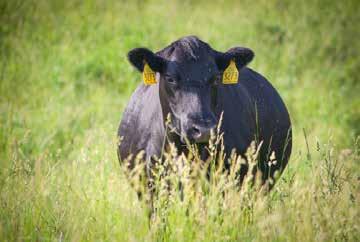
OFFICERS:
President
RANDY WARNER Sharpsburg
President Elect
ALLAN BRYANT Eminence
Vice President
DANIEL HAYDEN Whitesville
Treasurer
KEN ADAMS Upton
Past President
JEFF PETTIT Sebree
KCA Program Chairman
ADAM CHUNGLO Harrodsburg
KBC Chairman
RYAN MILLER Campbellsville
KBN Chairman*
ALLAN BRYANT
Beef Solutions Chairman*
DANIEL HAYDEN *ex officio
REGION 1
Wayne Zoglmann, John Mark Brown, Dale Gold, Greg Roberson, Gary Woodall, Coleman Ladd, Susan Zoglmann, Bill Plemmons, Kenton Howard, Steve Dunning, Conner Williams
REGION 2
Phyllis Gentry, Joe Lowe, Allison Nissley, Rayetta Boone, Robbie Hatfield, Chris
Imbruglio, Maggie Webb, Andy Joe Moore, Adam Thomas, AJ Mitchell, Isaac Thompson, Kenneth Green, Trent Jones, Josh Morris, Joe Mike Moore, Amy Cecil
REGION 3
Amanda Hall, Nathan Lawson, Allen Phillips, Irvin Kupper, John David Yount, Lincoln Clifford, Abbey Biddle, Ben Tinsley, Crystal Harrod, Kyle Bush, Michelle Simon, Craig Retzlaff
REGION 4
Amy White, Brad Reynolds, Chad Anglin, Phillip Stamm, Danielle Harmon, Brandy Graves, Jodi Purvis, Mike Ravencraft, Ronnie Lowe, Logan Carter, Jason Crowe, Rob Amburgey
REGION 5
Phillip Reese, John Settles, Natalie Wesley, Doris Hamilton, Freddy Harris, Brent Williams, Anne Bays, Tommy Glasscock, Josh Wethington, Arch Sebastian, Terry Mattingly Executive Committee members in bold
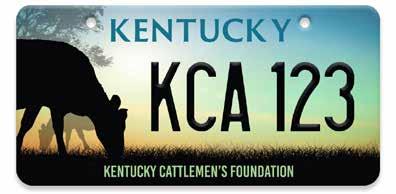
at your
county clerk's office! Kentucky Cattlemen's Foundation will receive $10 from each purchase and renewal to benefit education, leadership and youth programs.

Dave Maples
Kenny
Kelly
Todd Brown Graphic Designer
Bradon Burks KBC Director
Rachel Cain Membership and Communications Coordinator
Amelia Carter KBC Director of Industry Relations
Danny Coy Video Production Specialist
Jake Harrod KBN Program Coordinator
Dan Miller KBN Industry Coordinator
Debby Nichols National Advertising Sales, LAN
Katie Pratt Communications Manager
Alex Scott MS, RD, LD KBC Southeast Regional Director of Nutrition
Becky Thompson Director of Kentucky Beef Network
Kelly Tucker KCA Collections & Compliance
Nikki Whitaker Director of Operations & Policy

Randy Warner KCA President
Well, June finally got here, and I hope this month’s thoughts finds you well and ready for hay season. As I sit down to write this month’s article, I’m taken aback thinking about the Farm Bureau Beef tour that I had the pleasure of attending and how different parts of the United States go about doing the same task differently.
The tour took place in Louisiana close to the Gulf. There, they move their cattle north during hurricane season to protect them from the torrential rains and floods that accompany them. It gives them the opportunity to pair up the calves and worm the cows. To me, that’s about the same as our spring work of vaccinating our calves and turning out on new grass for the summer season. It just amazed me how with each ranch we visited on the tour had their own unique take on similar
production practices.
Around here, we select bulls for different reasons whether it be for calving ease, terminal traits, maternal instincts or ribeye area. Down there, they try to select for those traits too but also look for animals that manage to stay cool in the summer so hide color matters. Producers there want cattle out in pastures and not in tree lines. Also, one thing I learned was that something as small as a mosquito can kill a bull as they will swarm and smother them. That they can keep. I don’t want anything to do with enough mosquitoes that can do that to an animal.
This beef tour was my first but definitely not my last. I would definitely go on another one just to get an insight into how farmers and

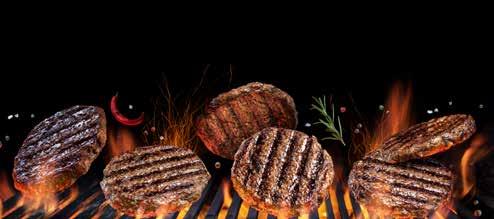
ranchers in different areas go about dealing with the things Mother Nature has in store for them.
As for things going on in our great state, I can proudly tell you that our Kentucky Junior Cattlemen’s Association has surpassed 1,100 members, and for that, I am extremely grateful. One of my pet projects was to see more juniors get involved in the association, and it looks like it is starting to take root. I hope we as an organization take this opportunity to continue to help them in any way possible. If you have the chance to attend your regional meeting, please do so as the juniors have a great presentation that shows what they have been able to get done and what they have planned. Getting back to the regional meetings, Rachel, Nikki and Becky have plenty of information about what is happening around the state and within KCA. Please try to attend if at all possible. You won’t be sorry.
At our farm, we’re getting ready to start hay season. We will start spending long hours in the field, eating on the go while trying to beat the rain. As we begin this important task of producing winter feed for our animals, I ask that you be careful out there, especially around equipment. Above all, please follow all safety precautions and have a safe harvest. Hopefully the April and May rains have energized our hay fields so we will have an abundance of hay to get us through this coming winter especially since this past winter was a rough one.
As I close this month’s thoughts, I want to make sure that you know I really appreciate all the support that you’ve given me and to let you know I’m always available if you ever have any questions. Thank you and God Bless.


Jonathan Shell Agriculture Commissioner
As we step into Dairy Month, June is the perfect time to pause and reflect on the hardworking men and women across Kentucky who ensure our refrigerators are stocked with milk and other wholesome dairy staples, such as butter, cheese, ice cream and yogurt.
Dairy farmers are often the first to rise and the last to rest, quietly fueling our communities with dedication, resilience and care. Their work doesn't stop for weekends or holidays. Cows need milking every day, rain or shine, and each morning on a dairy farm begins with a sense of duty that few professions require. These farmers are not just producers of food; they are caretakers of our land, stewards of animal welfare and contributors to rural economies around the state.
In a time when many Kentuckians are increasingly disconnected from the source of our food, Dairy Month serves as an important reminder: the milk in our coffee and the cheese on our sandwich didn’t just appear in the store – it came from a farm, tended by people whose commitment often goes unseen and underappreciated. Few things are as refreshing – or nutritious – on a warm day as a tall glass of cold milk. With essential nutrients such as calcium, potassium and vitamin A, plus protein to help build and repair muscle tissue, milk is a great choice for active people.
Summer officially starts this month, so June is the perfect time to celebrate dairy foods and our dairy farms that produce them. Kentucky’s dairy cow inventory was estimated at 41,000 head at the beginning of
this year. Our bovines produced 846 million pounds of milk in 2024, more than 20,000 pounds per head.
Our dairy farmers are embracing innovation. From robotic milkers that allow cows to milk themselves to modern technology that monitors herd health, today’s dairy operations are more efficient and environmentally conscious than ever before. This balance of tradition and progress is something to be admired and supported.
So, this month, raise a glass filled with the official state drink of Kentucky (it’s not bourbon, it’s milk!) to our dairy farmers. Their work sustains us in more ways than one. Whether it’s a scoop of ice cream on a hot summer day or a spoonful of cool, creamy yogurt, every bite is a reminder of the hands behind the harvest.
Thank you, Kentucky dairy farmers! Your work is essential, your impact is lasting, and your dedication does not go unnoticed.






Dave Maples Executive Vice President
If you have been watching the cattle market−and I am sure you have− the market has posted some of the strongest days in feeder cattle market history, with record high futures prices, a record feeder index and the highest ever national and Kentucky steer prices all at the same time. The feeder cattle market is strong, and that mirrors the breeding bull market as well. I had the opportunity to attend several bull sales this spring and $6,000 seemed to be a consistent price for a good bull.
When it comes to the fed cattle market, weights have continued to push higher amid tighter supplies. As I watch the Live Cattle Futures market, the price just continues to climb. Technological advances in raising cattle as well as genetic advances have allowed the fed animals to produce more beef per head.
One interesting trend is that of quality grades over time. Choice carcasses represented about 50-55% of the cattle in the 2000s but have more recently been in the 75% range. It is easy to see that the genetic improvements, cow-calf and stocker management practices (thank you Ag Development Board and KBN educational programing) and feedlot technologies have played roles in these increases.
It is also worth noting the recent increase in carcasses grading prime. About 3-4% of cattle graded prime in the 2000s compared to 10-12% in recent years. In the past few weeks, more cattle have graded prime than select.
We know that the supply of cattle is low, however, beef production has held steady over the past few years due to higher carcasses weights. Beef demand has been really good which reflects in higher retail prices.
I read my friend Nevil Speer’s articles often and appreciate his take on the issues from a data driven point of view. I agree with Nevil and wish that our beef producers would always think about the consumer when they make the decision on what bull to breed their cows to each year. Because as Nevil say’s “the consumers are the business.” Consumers are the business- they are the market makers. We can enjoy all these nice calf prices but understand this success is all attributable to beef demand. Consumers like the product you are producing. This is illustrated in a 210 Analytics’ year-end retail meat sales data: beef accounted for 55% of all sales and captured 78% of all new spending in 2024. A record-fed steer market on bigger volume is no accident.
The industry is doing a good job, and the Beef Checkoff is the cornerstone of that success from the early days to what we are enjoying today.

A three-year research study was conducted using Fescue 7 at Morehead State University. Researchers measured cow body condition scores, calf weights, hair shedding, body temperature, and cow behavior.
Cows provided the Fescue 7 mineral had significantly better body condition scores, quicker hair shedding, lower body temperature and grazed more frequently during the heat of the day. We believe that our research shows that Fescue 7 mineral can be an effective tool in combating heat stress associated with fescue toxicosis.”
Dr. Patricia Harrelson
AssociateProfessorofAnimalScienceatMoreheadStateUniversity
“Some years ago, we lost almost an entire calf crop due to the fescue. Needless to say I was looking for answers. A minderal salesman introduced me to Gro-Tec mineral and a product called Fescue 7. Without going into great detail this stuff is a gamechanger. Not only did it help tremendously with the fescue but it also cut down our pinkeye and foot rot problems. Sent our breed back rates on the high 90% range.”
Jason Schroeder, Schroeder’s Black Herefords Jefferson City, MO
Fly control has never been easier.


Gold Buckle Tubs contain a proprietary blend of enzymes, bacteria and yeasts that are research and University trial proven to GREATLY increase fiber and forage digestion.
100% Chelated and complexed
Trace Mineral profile for OPTIMUM availability to cow/calf
• Decrease hay and forage inputs 15-30%
• Improve WW and YW 20+ lbs
• Maintain or improve BCS on heavy milking cows with calf
Improve conception rates 5-10%
• Decrease the need for high protein supplementation



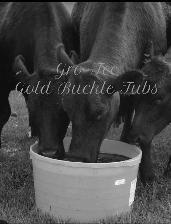




submitted by Carol Spiegl
The Barren County Cattlemen's Association met on April 17. The meeting and ribeye sandwich were co-sponsored by Superior Fence Systems, Inc. and The Barren County Progress. Pictured top right, Jeff Chapman and Lindsey Winchester with Superior Fence Systems and Jeff Jobe, Barren County Progress publisher.
Jeff Chapman spoke to the membership about their business and what it offers to Barren County farmers. He introduced Winchester as the new office manager. Jeff Jobe told the story of his journey into publishing and becoming the owner of The Barren County Progress, the weekly newspaper.
Top left: Maggie Webb informed the members about her trip with Kentucky Cattlemen's Association to Texas as part of the Beyond the Bluegrass Industry Tour. The tour is aimed at educating emerging leaders and producers on segments of the beef industry that occur after their cattle leave their farms. The tour visited farms, feedlots, research facilities and packing plants.
submitted by Catherine Atchinson
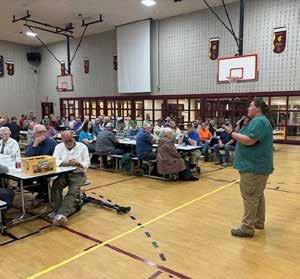
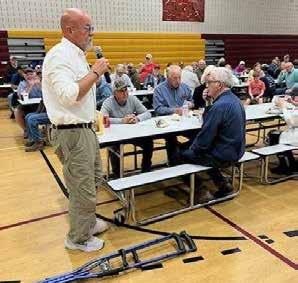
The Henry County Cattlemen’s Association recently hosted their April meeting. Laura Stephenson, dean of the University of Kentucky Martin-Gatton College of Agriculture, Food and Environment, was the featured speaker. The association also awarded four, $1,000
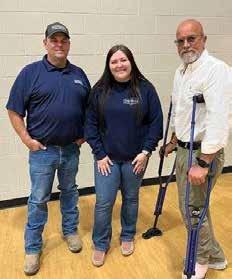

scholarships to deserving students. Scholarship recipients were Henry County High School seniors Callie Derossett, Wade Moore and Brenna Perkins and Kylee Morris, a Henry County native who is a freshman at Midway University. Pictured are Henry County Cattlemen’s Association President John Allison, Stephenson, Derossett, Moore, Perkins, Morris and Megan Wetenkamp, Henry County agriculture and natural resources extension agent.

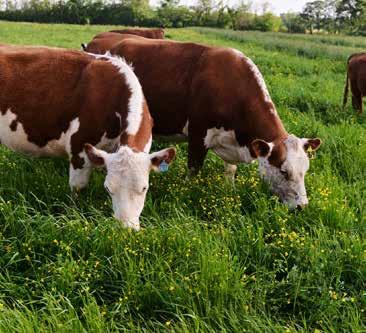

Every summer, broadleaf weeds and brush species creep into pastures, stealing nutrients, reducing forage, and decreasing grazing capacity.
Take back your land with a one-tank spray solution.
Alligare’s GUNSLINGER® AMP + CLEARGRAZE® is the ultimate pasture protection combo, designed to tackle your toughest weed and brush challenges in one efficient pass.
Darrh Bullock University of Kentucky
Matt Spangler University of Nebraska
Bull selection is one of the most important decisions that a beef producer makes and can have a lasting impact on profitability. Factors such as the market endpoint of calves (e.g., newly weaned or finished cattle), whether replacements will be retained, and the level of nutritional management provided to the cow herd all impact which traits should be selected for and at what level. Understanding this complex relationship can be the difference between buying a “good” bull and buying the right bull.
The eBEEF.org team, a group of beef cattle geneticists from across the U.S., is trying to determine how beef producers are currently selecting their bulls and will use this information to develop educational materials to help improve this process. Knowing which traits to select for is often not the problem, it is the degree to which each should be emphasized that can be highly variable from producer to producer and can often be challenging to determine. Too often this process is more ‘seat of the pants’ rather than by factors affecting profitability. For example, trying to find the optimal level of calving ease without sacrificing profit by not emphasizing traits like sale weight of the calves enough.

To assess how beef producers are selecting bulls, within their level of management, we are asking you to fill out a brief survey. This should take approximately 10 minutes of your time and provide a wealth of information for the beef industry! This information will be used to compare the survey results to values generated by iGENDEC, a software package that determines the most profitable level of emphasis that should be placed on each trait within a specific production system.
Several incentives are being offered to encourage participation in this survey. The first is a random drawing for five $100 gift cards generously donated by the Beef Improvement Federation (beefimprovement.org). The second is a special webinar that will be offered to everyone that completes a survey, and provides their email address, to discuss the findings of the survey and resulting bull selection strategies. Lastly, and possibly most importantly, knowledge gained by beef producers by going through this process and the entire beef industry through better bull selection decisions.
Katie Pratt Kentucky Cattlemen's Association
ELIZABETHTOWN, KY− The next generation of Kentucky cattle producers showcased their animal care and safety skills during the second Kentucky Junior Cattlemen’s Association Cattle Working Contest.
“This contest gave me real-world experience, and I learned more about working cattle the right way to BQA standards,” said Will Beckley, a member of the Cultivated Cowpokes team and a junior at Estill County High School.
The contest is a joint effort of the Kentucky Beef Network, Kentucky Beef Council, Kentucky Junior Cattlemen’s Association and the Kentucky Beef Quality and Care Assurance program. Before competing, all students had to be Beef Quality and Care Assurance certified.
“The Kentucky Beef Network’s involvement in the KJCA Cattle Working Contest is vital because it gives young people the opportunity to receive technical, hands-on training they may not get elsewhere,” said Becky Thompson, director of the Kentucky Beef Network. “These experiences build real-life skills they’ll carry with them throughout their lives and future careers. It’s incredibly rewarding to help lead and train the next generation of cattle producers.”
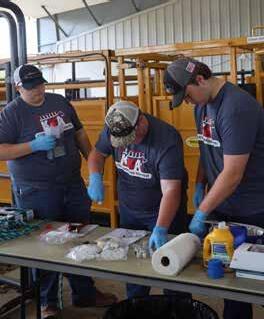
“There are so many young people involved in the beef industry who don’t always get the recognition they deserve for the work they do at home,” said Bradon Burks, director of education for the Kentucky Beef Council. “Not every student wants to give a speech or do an interview— but many thrive in hands-on competitions that feel practical and relevant to real-world agriculture. It’s an incredible opportunity for us to help guide and train future cattle producers as they build and sharpen their skills at an early age.”
In only its second year, the contest expanded to accommodate more teams. A qualifying round was held in March with the top 10 teams advancing to the state competition in May. At the state competition, a team from Henry County took home top honors.
“It is exciting to see the cattle working contest gaining popularity among our junior members,” said Macey Thompson, KJCA president. “This contest provides high school-aged participants with the opportunity to learn about and compete in one of the most common practices on beef cattle farms- while emphasizing both safety and ethical handling. By offering this contest, we are able to provide valuable educational materials and

resources to those involved in, or interested in, the production side of Kentucky’s beef industry.”
During the competition, students developed a cattle processing plan that they used as their chuteside guide. The plan included procedures, products to be used, route of administration, application location, dosage and pre-slaughter withdrawal time. They also had to solve a team problem that required them to calculate vaccination dosage and costs. Then, they went to the chute and had to work three weaned calves within 20 minutes using BQCA guidelines. The students gave each animal a dewormer and ear tag, conducted an ear notching/BVD test and administered a 7-way clostridial and respiratory complex vaccines with a focus on cattle handling and safety.
“I learned how to properly vaccinate to industry standards,” said Ethan Wooten, an Adair County sophomore. “When I got to veterinary school, it will help me to have had this experience.”
Students were scored on their cattle processing plans, team problems and chute-side techniques.
Dr. Charles Townsend is the staff veterinarian at Burkmann Nutrition
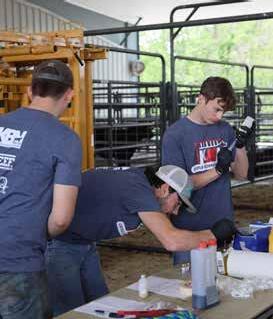
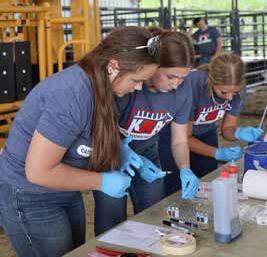


and was one of the contest judges. Safety of the participants and the cattle was his top concern. During the event, he was charged with making sure the participants handled the vaccines property, vaccinated the cattle correctly and had proper needle handling.
“Vaccinating correctly is a cattle health issue and a quality issue,” Dr. Townsend said. “If you don’t vaccinate correctly, your animals don’t get the proper immune response and it could affect the quality of your end product. Hopefully, this contest helps teach kids the proper way to vaccinate so they can use that knowledge with their own herds.”
The contest was open to high school students and high schools as well as FFA, 4-H clubs or county cattlemen’s associations could field teams.
Gabby Barnes, Adair County agriculture teacher, selected her team by having one of her classes work a load of cattle. All students in the class were BQCA-certified prior to the working. As they worked cattle, she
“Our team worked cattle for people in the community to help them prepare for the state competition,” Godbey said.
Adair County also received a tremendous amount of support from the local agriculture community.
“Farmers from all over the county brought in cattle several times a month so the kids could work them,” Barnes said. “The Adair

LARGER SEED HOPPERS • CLEAN VIEW SIGHT GAUGE • CLEAR VIEW SEED MONITOR WINDOW • 12 FT DRILL • NEW TECHNOLOGY HIGH SPEED DRILL 8MPH! • SWING TONGUE FOR 8”10” TRANSPORT • WILL PLANT BIN RUN SEED! • FINANCE OPTIONS AVAILABLE!

Gil Myers Ph.D., Magnolia, Kentucky
This article is the first in a two-part series on cattle nematodes and parasite control.
The University of Kentucky IRM Calendar includes a timely recommendation to deworm spring calving herds in mid-summer, “Deworm cows and calves (midJuly is optimum), especially if not dewormed in the spring.”
Herds grazing permanent pasture cannot escape nematode (gastrointestinal parasite) infections. Calves are born worm-free, picking infective larvae as they graze. March-April born calves have developed moderate infections by mid-July. These infected calves are contaminating pastures daily with worm eggs. High temperatures and humidity in late summer favor rapid development of eggs to infective larvae. When temperatures reach 75
degrees F along with 70 % humidity, eggs can develop to the infective stage in 10 days. As a result, a sudden rise in pasture contamination occurs and nematode infections in calves increase dramatically from July until weaning (Figure 1).
Mid-summer deworming with an effective dewormer prevents egg shedding, high infection levels and production loss. In most beef cattle herds, lost production is subclinical and not noticed. Calves appear normal. Published studies document production losses due to nematode infections of 25-30 pounds.
Benefits Of Mid-Summer
• Reduced nematode infections in the cattle, resulting in lower pasture contamination during late-summer grazing.
Figure 1: Maturation of eggs to infective larvae occurs progressively faster as weather warms, resulting in suddenly increased pasture contamination levels.
• Improved milk production in beef cows as reported in a University of Missouri study. The results ranged from 20-29 % more milk and were statistically significant *
• Heavier calves at weaning due to lower nematode infections and better nutrition from the cow. Producers can expect worm egg shedding to stay low for at least four weeks after effective deworming. This means less contamination and fewer infections at a critical time in the calf growing cycle.
Timely deworming is a cost-effective way to increase herd production. With high prices for calves and the relatively low cost of effective dewormers, producers should this option. Plan now to implement mid-summer deworming to produce heavier calves at weaning.
*Journal of Animal Science, Vol 66, No. 6, June 1988










Rachel Cain KCA Membership and Communications Coordinator
Class X of the Leadership Development Program recently completed its third and fourth sessions, deepening their understanding of state policy and agricultural business.
Held in Frankfort, the third session centered on state policy and legislation. The program began with participants attending a meeting of the Senate Agriculture Committee, where they observed the committee meeting and learned more about the legislative process.
Agriculture Commissioner Jonathan Shell addressed the group, sharing his priorities for Kentucky agriculture and discussing emerging opportunities and challenges for the
state’s cattle producers. Participants also visited both the Senate and House galleries to observe legislative sessions in action.
On the third day, the class attended the House Agriculture Committee and met with Committee Chair Representative Myron Dossett and Representative Kim King. Participants had the opportunity to meet with their senators and representatives to share their priorities as cattle producers. The day concluded with a meeting with Rocky Adkins, senior advisor to Gov. Andy Beshear, who provided insight into his role within the governor’s office and highlighted the importance of agriculture to Kentucky’s economy.
The last day of Session Three took place at the C. Oran Little Research Farm, where Les Anderson, UK beef


specialist and Kirk Vanzant, UK research specialist, discussed current research projects at the UK Beef Unit. To wrap up the session, the class visited Spark Community Café in Versailles for lunch. There, volunteers shared the café’s mission and history, highlighting its unique role in the local community.
Session Four of the Leadership Development Program took place in Morehead and spotlighted agricultural business, finance and the unique agricultural landscape of Eastern Kentucky.
The session began with a visit to Sebastian Farms in Jackson, which is operated by class participant Arch Sebastian and his family. Participants

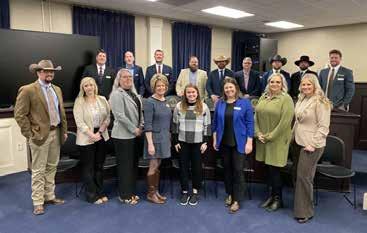
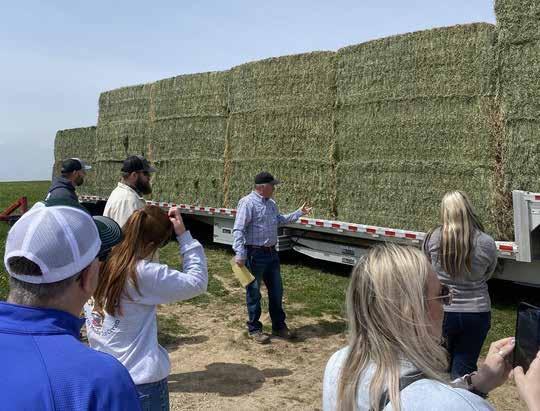

toured the farm and enjoyed lunch in a recently renovated barn, now used as a wedding venue, while learning about the family’s operations. Next, the group traveled to the Robinson Center for Appalachian Resource Sustainability (RCARS), where Director Daniel Wilson shared insights into ongoing agricultural research and recovery efforts following the severe 2022 flooding. The visit also included a handson woodworking session where participants created their own cutting boards with assistance from RCARS staff.
Day two featured a great lineup of speakers.
• Heather Graham, East Kentucky value chain coordinator for The Food Connection, highlighted her work with the Kentucky Value Chain Collaborative, emphasizing market development for local food producers.
• Doug Wilson from the Division of Conservation addressed

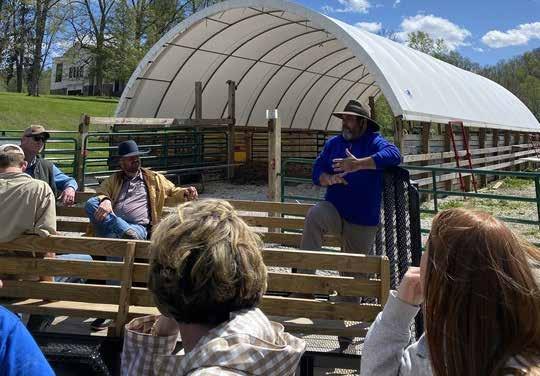
environmental challenges specific to Eastern Kentucky farmers.
• Jonathan Shepherd, UK extension specialist, led a practical session on farm finances and tax strategies.
• Flint Harrelson provided a tour of the Morehead State University Farm and discussed the university’s mission and philosophy in agricultural education.
• Aleta Botts from the Kentucky Farmland Transition Initiative spoke on strategies for preserving Kentucky farmland.
• Will Snell, UK agricultural economist, concluded the speaker series with a timely update on agricultural policy and trade and recent Kentucky Agriculture Leadership Program sessions.
• The day ended with a tour of Harold White Lumber, led by Ray White, where the class viewed the process of making hardwood.
White discussed the evolution of the family-owned business since 1968 and highlighted the unique environmental conditions that make the region optimal to grow hardwoods.
On day three, the class visited Hinton Mills a longstanding, family-run feed and farm supply business. At the Plummers Landing location, Joe Fraley explained the feed manufacturing process, while Adam Hinton shared the history and values that have guided the company since its inception in 1918. The class then visited the Kentucky Welding Institute, where Director of Training Ashley Applegate discussed KWI’s growth and commitment to student success, workforce readiness, and community building. The session ended with a tour of Stevens Beef led by Jeff Stevens and Will Blaydes in Flemingsburg.
Class X is funded through the Kentucky Cattlemen’s Foundation. Session Five is scheduled for July 2025 in Denver, Colorado.

Michelle Arnold DVM (Ruminant Extension Veterinarian, UKVDL)
This year, the number of skunks diagnosed with rabies in Kentucky is already unusually high, especially in the Bluegrass area of Central Kentucky (Figure 1). With that fact in mind, it is a good time to review rabies in cattle and what to do in the event of human exposure.
Do cattle get rabies? Yes, all species of livestock are susceptible to rabies, although cattle and horses are the most frequently reported infected livestock species. Rabies is caused by a virus that affects the nervous system and is transmitted by the saliva of an infected animal, usually via a bite or by saliva coming in contact with mucous membranes (eyes, nose or mouth) or an opening in the skin. The virus then passes to the brain by peripheral nerves, so the incubation period varies depending on the site of injury. The further the bite is from the brain, the longer it takes the virus to travel that distance before the animal shows symptoms of disease. Once the virus reaches the brain, it causes encephalitis with rapid progression of the disease over the course of a few days, culminating in death.
How do Kentucky cattle get exposed? Rabies is uncommon in cattle but there are times when cases in wildlife increase and that
presents more opportunities for cattle exposure. In Kentucky, rabies is typically transmitted through the bite of an infected skunk; the closer the bite is to the head of the cow the shorter the incubation period. Unfortunately, cattle are very curious and will sniff or lick an unusual animal, resulting in a bite on the nose.
Which wild animals are most likely to transmit rabies and how can they be recognized? Bats, raccoons, skunks, foxes and coyotes are the most common carriers of rabies. Different areas of the country will have a predominant form that causes most of the cases. Skunks form the primary reservoir through the north central United States extending down through Texas and east to Arizona. In general, rabies should be suspected in wildlife acting abnormally. Rabid raccoons, foxes and skunks typically show no fear of humans and are ataxic (wobbly), frequently aggressive and they are active during the day rather than around twilight as usual. They may attack pets, especially in urban and suburban areas. Rabid foxes and coyotes can enter yards and attack dogs and humans. The same is true of bats that can be observed flying in the daytime; resting on the ground,
paralyzed and unable to fly; attacking humans or other animals; or fighting.
How long after a bite does it take for a cow to develop symptoms of disease? Generally, the incubation period from the time of the bite until development of clinical signs is one to two months but can be as short as two weeks. Death occurs within three to four days of showing symptoms of disease.
What are the clinical signs (symptoms) in cattle? The initial signs are non-specific and can make diagnosing rabies challenging. There are two common forms seen in livestock: the “paralytic” form and the “furious” form. An individual animal can exhibit symptoms of both forms. Paralytic rabies is characterized by a progressive ataxia (incoordination, wobbly gait) that eventually leads to paralysis of the extremities. Cattle often demonstrate knuckling of the fetlocks, a swaying or unsteady gait, and a flaccid tail. Drooling may be observed because of progressive pharyngeal paralysis causing an inability to swallow. Vocalization may be altered, or the animal may attempt to bellow but make no sound so it may appear to be yawning. Coma and death generally occur within one to two days after the animal goes down (recumbency). Death is generally
Post Exposure Prophylaxis Refresher
If the patient needs PEP: Never been vaccinated: Rabies Immunoglobulin (RIG) and 4 vaccines (Deltoid)
caused by respiratory failure. Furious rabies is characterized by altered mentation, hyperexcitability, and the animal may respond excessively or aggressively to external stimuli, such as sound, light, movement or touch. Loud bellowing vocalization may be demonstrated. Bulls often show increased sexual excitement and are observed to mount inanimate objects. Cattle with furious rabies can be dangerous, attacking and pursuing humans and other animals. Lactation ceases abruptly in dairy cattle. Some cattle show marked straining (tenesmus) when trying to urinate or defecate. Clinical signs progress to paralysis, recumbency, coma and death. Regardless of form, rabies should be on the list of possibilities for cattle that exhibit abnormal behavior, an inability to swallow or choke, hypersalivation (slobbering) and neurologic abnormalities. What other diseases look like rabies in cattle? In the early stages, rabies can easily be confused with other diseases or with individual aggressive cattle. More importantly, rabies may be overlooked in areas where the disease is uncommon. Rabies should always be considered as a possible diagnosis for clinical signs related to the brain and spinal cord (central nervous system). Clinical findings may be similar to a number of other diseases including bacterial meningitis, brain abscess, listeriosis, botulism, Aujeszky’s disease (pseudorabies), hypomagnesemia, nervous ketosis and the brain form of Histophilus
somni.
How can a person become infected from a rabid cow? The rabies virus is found in saliva and nervous tissue (brain, spinal cord, nerves). Cattle can shed rabies virus in their saliva and can potentially infect other animals and humans. Generally, the first thing noticed by producers is the animal appears to be choking which prompts owners, and veterinarians, to insert a hand into the mouth in an attempt to remove a foreign object. Anyone examining a suspect rabid animal or when collecting/handling specimens should wear personal protective equipment to prevent exposure to saliva. PPE should include disposable gloves and goggles or mask to prevent contact of mucous membranes or open cuts on skin with saliva or nervous tissue.
What do I do if I think I am exposed to rabies? If you are exposed, immediately wash the wound or cut with soap and water. If saliva comes into contact with mucous membranes, immediately flush the area with fresh clean water. Consult your healthcare provider for bite wound management which should include appropriate antibiotic therapy, a tetanus immunization (if not current), and an evaluation for rabies “post-exposure prophylaxis”. For unvaccinated people after exposure, the complete post exposure treatment consists of administration of rabies immunoglobulin at the site of the bite and a series of rabies vaccinations (Figure 2). The Kentucky Department for Public Health, specifically the state public
health veterinarian, can provide recommendations for post-exposure prophylaxis to veterinarians and healthcare providers.
How is rabies diagnosed in cattle? When rabies is suspected, the brain tissues of rabies suspect animals are examined for the presence of rabies infection at the Division of Laboratory Service in the Kentucky Department for Public Health. No definitive test is available for rabies diagnosis in a live animal. Typically, the suspect animal is euthanized and the head removed for shipment to the laboratory. If at all possible, animals should be euthanized by lethal injection of pentobarbital or another approved euthanasia solution. The use of a captive bolt gun or a gunshot to the head can result in excessive tissue trauma that can interfere with an accurate diagnosis. In addition, these methods potentially increase the risk of rabies virus exposure to personnel when removing the brain. The entire carcass, entire head or the removed brain can be submitted for testing. The euthanasia method should ensure that the brain is not damaged and the brainstem is included.
What happens if an animal is positive? The local health department will conduct an investigation to identify the people and animals that were potentially exposed to the rabid cow and provide recommendations for rabies post exposure prophylaxis for people. The Kentucky Department of Agriculture
is responsible for quarantine and case management of livestock suspected of rabies exposure. If a rabid cow is nursing a calf, the calf is considered exposed to rabies. If a nursing calf is rabid, the cow is considered exposed to rabies. KDA will base decisions for case management on current scientific research and available evidence.
Is there a rabies vaccine for cattle? Yes. Rabies vaccination is recommended for valuable stock, show cattle or livestock that has frequent contact with the public. If exposed to the rabies virus, livestock that are current on rabies vaccination with a USDA-licensed vaccine approved for that species should be given a booster vaccination immediately and observed for 45 days. Unvaccinated livestock should be euthanized or kept under strict quarantine for four to six months after a rabies exposure. Unvaccinated livestock with a high-risk exposure to rabies should not be sold, and products from these animals (meat, milk) should not be consumed during this quarantine period.
Is it safe to eat meat or drink milk from an infected animal? Neither milk nor meat should be consumed from an animal showing symptoms of rabies since virus can be present in the tissues and milk of rabid cattle. However, pasteurization and cooking will inactivate rabies virus so drinking pasteurized milk or eating thoroughly cooked animal products is not called a true rabies exposure. Cattle exposed to rabies cannot be processed at a USDA facility; however, they may be custom slaughtered. If custom or home slaughtered for consumption, it should be slaughtered immediately after exposure, and all tissues should be cooked thoroughly. Handling and consumption of uncooked tissues from exposed animals also carries a risk for rabies transmission. People handling exposed animals, carcasses and tissues should use appropriate personal protection.
What you need to know
• Rabies should be on the possible diagnosis list for any cattle showing signs of abnormal behavior, inability to swallow and central nervous system abnormalities.
• Rabies virus is shed in saliva; wear personal protective equipment (gloves, goggles, mask) during physical examination, necropsy and when collecting specimens.
• Cattle are considered exposed to rabies if:
• A calf is nursing a rabid cow
• A cow is nursed by a rabid calf
• A cow has been bitten by a rabid animal
• Rabies in animals is reportable to the Kentucky Department of Public Health in Frankfort. The Kentucky Department for Public Health, specifically the state public health veterinarian, can provide recommendations for post-exposure prophylaxis.
• Fresh, intact brain is needed for the rabies diagnostic test.
See https://vdl.uky.edu/ epidemiology for a full range of rabies maps by date, county or species affected.

Kentucky is the largest beef cattle state east of the Mississippi River
FRANKFORT, Ky. (May 5, 2025)
– Kentucky cattle producers and industry representatives joined Kentucky Commissioner of Agriculture Jonathan Shell Monday as he signed a proclamation commemorating the month of May as Kentucky Beef Month.
“With 869,000 head of beef cattle in the commonwealth, Kentucky remains the state with the largest beef inventory east of the Mississippi River,” Commissioner Shell said.
“We retain that title with the hard work of our cattle farmers.
I ask that Kentuckians join me in recognizing their effort, diligence and perseverance as we celebrate May as Kentucky Beef Month.”
The United States is the world's largest producer of beef, primarily high-quality, grain-fed beef. Kentucky ranks 14th nationally for total cattle inventory and eighth in the nation for beef cattle. According to the National Agricultural Statistics Service, Kentucky is home to 31,060 beef
cattle producers of the 69,400 total farms in the state.
“May is Beef Month — a time to honor the hardworking Kentucky beef producers dedicated to bringing highquality beef to your table,” said Kelly Baird, Kentucky Beef Council director of communications and events.
“During May — and throughout the entire year — we celebrate Kentucky farm families and the vital role they play in ensuring a safe, sustainable and nutritious food supply. Through every challenge, our beef producers work tirelessly to support our communities, our economy and our commonwealth.”
January 2025 numbers for all cattle inventory are down 2% from 2024, with beef cattle numbers seeing a larger decrease of 2024 over last year. Kentucky’s decrease in beef cattle numbers matches what’s happening nationally. The U.S. beef cattle reached a 64-year low in 2025. Several factors including low calf prices, high costs and drought
have played a role in the declining inventory.
In contrast, the lower number of beef cattle has created a higher market demand and driven up sale prices for farmers. The tight national cattle supply and higher market prices will likely contribute to higher agricultural receipts for the state. In 2024, gross receipts from cattle production totaled more than $1 billion, ranking it in the top five of all Kentucky commodities.
It’s predicted Kentucky’s strong livestock sector could help maintain overall cash receipts above $8 billion for 2025, approaching the all-time high of $8.3 billion hit in 2023. The top five Kentucky counties for number of beef cattle are:
• Barren
• Pulaski
• Madison
• Breckinridge
• Bourbon.

802 ACRE FARM & EQUIPMENT AUCTION IN BUTLER COUNTY, KY
Turnkey Cattle Operation: Home, Barns, Shops & 8 Income-Producing Rentals!













Chris Teutsch UK Research and Education Center, Princeton
What is a weed? In row crops it is easy to define…something that you didn’t plant! The definition becomes a little murkier in pastures. Pastures are not monocultures of one single species but rather a complex mixture of grasses and legumes, some planted and some naturally occurring, along with a wide variety of “weedy” forbs. My working definition of a weed in pastures is a plant that you cannot figure how to get a cow to eat.
Weeds in pastures are often viewed as the “problem.” However, in many cases they are a “symptom” of other underlying issues such as poor grazing management or low soil fertility. Until these other issues are addressed, successful weed control in pastures will be elusive. In this article, I will outline an integrated approach to weed control in grasslands.
Too often when we talk about weed control in pastures and hayfields our focus is on 1) identifying the weed and 2) figuring out what herbicide will kill it. Don’t get me wrong, we have some very effective herbicides for broadleaf weeds in pastures. The problem is not necessarily killing the targeted weed but rather what remains after that weed dies…a bare spot in the pasture. What grows in bare spots? Weeds! You can see how the use of herbicides can become a reoccurring cycle if we don’t address the underlying issues of why that weed was present in the first place.
Soil fertility. Poor soil fertility in pastures and hayfields creates an environment in which desirable forage species find it hard to be productive and persistent. The first step in an integrated weed control program is to soil test and apply needed fertilizer and lime. The goal is to create an environment that promotes a thick and vigorous stand
⃣ Output per unit land area
⃣ Output per individual animal
UNECONOMICAL (UNDERGRAZED)
Stocking
of forage that does NOT leave a spot for a weed to get started.
Setting a sustainable stocking rate. Stocking rate is the number of animals on a given land area for a given period of time (usually the grazing season). When the stocking rate is too high, the system becomes unstable leading to the loss of desirable forages and the encroachment of weeds (Figure 1). Setting a sustainable stocking rate is the foundation of successful and profitable grazing systems. Stocking rate depends on a number of factors including soil type, slope, aspect, forage type, grazing management and soil fertility. In most cases, a sustainable socking rate for cattle farms in Kentucky will range between 2-3 acres per cow-calf unit.
Grazing management. Subdividing
Increasing risk A
UNSTABLE (OVERGRAZED)
larger pastures and implementing a rotational stocking system allows you to start managing grazing.
Leaving adequate residual leaf area (4-5 inches) and resting pastures between grazing events improves pasture productivity and drought tolerance and maintains a healthy and vigorous sod that excludes weeds. The exclusion of weeds is a key component of an integrated weed control program.
Mowing management. In hayfields, how closely we mow pastures can have a profound effect on both the productivity and persistence of forage stands. The invention of the disc mower is one of the worst things that has ever happened to orchardgrass stands. When not properly adjusted, disc mowers are capable of cutting very close to the
soil surface. Orchardgrass cannot handle close defoliation, especially as temperatures increase in late spring and early summer.
Selecting well-adapted forage species and varieties. The production and persistence of forage species is directly related to regional and local adaptation. Well-adapted forage species form a dense and vigorous sod that can exclude weeds from pastures and hayfields. Tall fescue, love it or hate it, is by far our best adapted cool-season grass. In addition to choosing regionally adapted species and varieties, it is also important to choose species that are adapted to the soils on your farm. For example, alfalfa is well adapted to Kentucky but not well adapted to poorly drained soils.
Clipping pastures. Timely clipping, before weeds go to seed, can be an important part of integrated weed control programs. Clipping pastures in mid- to late-spring can also improve forage quality and reduce tall fescue toxicosis by removing seedheads and allowing grass plants to regrow vegartively. It is important to remember that clipping pastures cost approximately $15 to $20/A or on a cow basis $30 to $60/cow. In the case of hard to control weeds, a herbicide application could be more effective and economical.
Judicial use of herbicides. Herbicides are an important tool of integrated weed control programs. As mentioned earlier, there are several very effective herbicides for toughto-control weeds. Matching the right herbicide to the target weed species and applying at the correct time is crucial for optimizing the impact of herbicide applications. More information of herbicide efficacy and optimal application timing can be found in UK extension publication, "AGR-207 Broadleaf Weeds of Kentucky Pastures."
In summary, it takes more than just herbicides to efficiently and effectively control weeds in grassland ecosystems. So, the next time you are reaching for that jug of herbicide take a moment and think about why and how that weed got there!
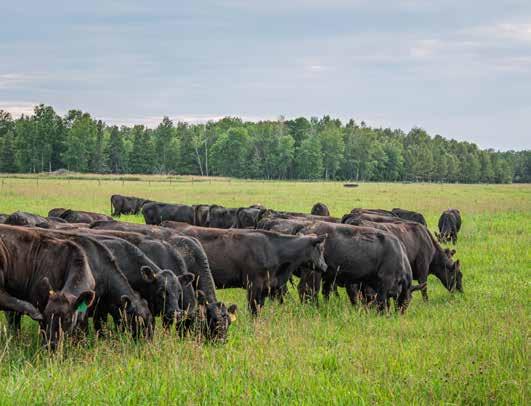
FEATURED UPCOMING EVENT
Electric Fencing for Serious Graziers: Installation and Troubleshooting • Grayson County Extension Office, Leitchfield, KY • June 3, 2025 • More information at https://forages.ca.uky.edu/ Events.
FEATURED VIDEO
This month’s featured video is: “Mixed Species Grazing as Part of an Integrated Weed Control Program" - Greg Brann. This video can be viewed at https://tinyurl.com/3bec39n7or going to the KYForages YouTube Channel.
FEATURED PUBLICATION
This month’s featured publication is: “PR-862 2024 Long-Term Summary of Kentucky Forage Variety Trials” by G.L. Olson, S.R. Smith, J. C. Henning, and C.D. Teutsch”. You can access it at https://tinyurl.com/4ft7d7ky or visiting your local extension office.
FENCING TIP
Always connect electrified wires with clamps. Loose connections result in loss of voltage. Connections should NOT be wrapped but rather clamped together with a high-quality clamp that is designed for high tensile fencing. Never use clamps that are constructed of dissimilar metals. Although economy clamps constructed of cast metal are sometimes available, they often fail upon tightening. Saving a few cents on clamps often leads to exponential headaches in the future.
FORAGE MANAGEMENT TIPS
• Clip pastures for seedheads and weeds.
• Use temporary fencing to increase paddocks numbers that will allow for longer rest periods as higher temperatures slow plant growth.
• Utilizing naturally occurring summer grasses such as crabgrass and johnsongrass.
• Start to graze summer annual and native warm-season perennial grasses when they reach a height of 18 to 20 inches. Stop grazing at a residual height of 8-10 inches.
• Scout pastures for summer annual weeds and control when small.
• Make plans to attend the upcoming Electric Fencing Troubleshooting School in Morgantown.
Kentucky Farm Business Management (KFBM) Program
The Kentucky Farm Business Management Program is a program of the Department of Agricultural Economics at the University of Kentucky. Extension specialists serve four farm analysis associations working with cooperating members to improve farm management techniques and decisions through recordkeeping and analysis. Currently, KFBM serves 355 farms that are representative of 49 counties. KFBM specialists work closely with diverse farm cooperators, and this article will share some of the realtime observations that they have seen this spring.
All KFBM regions experienced significant flooding in early April due to historical rainfall of 10 to 15 inches. Ohio Valley producers endured multiple wind events, an ice storm and a particularly destructive hailstorm. Farmers have been grading ditches, clearing debris, repairing buildings, equipment, and vehicles, and are still assessing damage from the most recent early floods. River levels are high for both the Mississippi and Ohio Rivers but are expected to drop rapidly in late April. All regions reported a delay in field work, especially planting, due to the cool, wet spring. Many crops that were planted at the first of the season in the Pennyroyal region will likely need to be replanted. As fields dry out, farmers are getting into planting and finishing tillage work. Specialists in all KFBM regions mentioned river bottom ground as a particular concern as water continues to stand in many places. The probability of these areas being planted late, or not at all, is high. Lincoln Trail and Pennyroyal reported hay and pasture ground is rebounding from the heavy rains and greening up nicely, stoking optimism for cattle farmers. There are lingering concerns about hay yields due to ground underwater. Many Purchase area crop acres have shifted from wheat to canola or rapeseed, which are currently in a bright yellow bloom across the region. The growing canola and rapeseed are primarily being grown with a contract for future use. A strong yield for these crops, coupled with a contracted price, would be a needed boost in cash flow. In the Pennyroyal area, wheat is growing fast after a brief slowdown due to cool temperatures. However, some areas in Pennyroyal experienced significant crop loss due to the flooding. Profitability for wheat, even those with strong yields, is a huge concern.
Lincoln Trail and Pennyroyal specialists noted good financial positions for cattle farmers and dairies due to steady, strong market conditions. Livestock producers in these areas expect the cattle market to stay firm for 2025, which is a needed reprieve after several years of
poor profitability. It’s not all good news on the cattle front. Pockets of Pennyroyal producers were faced with large death loss in January and February, which will negatively impact net farm incomes for 2025, especially on those that prematurely lost livestock purchased at higher prices. All KFBM regions reported steep declines in returns, often negative, for grain farmers. Many farmers in the Purchase area have had to refinance debts and stretch out loans to make up insufficient cash flows. Higher interest rates have made the debt service on these refinances more difficult for cash flow. Farms continue to see an impact on profitability due to interest rates in the 7-9% range. Negative returns were slightly abated by the receipt of economic assistance payments issued by the USDA through the Emergency Commodity Assistance Program (ECAP). These payments were issued on a per acre basis, $42.91 for corn, $29.76 for soybeans, $31.83 for canola, $23.63 for rapeseed, and $30.69 for wheat. To date, eligible KFBM producers have received 85% of the initial ECAP calculated payment, with the remaining 15% to be received in August if funds remain. Payments were a needed cash flow relief that helped producers mitigate increased input costs and depressed commodity prices. However, many KFBM producers reported negative returns, even with ECAP payments factored in. Despite reduced farm profits, several winter auctions in the Purchase area for farmland brought top dollar. The trend of non-farm investors using money from outside ventures to procure farmland continues to tick upward. Equipment purchases in Ohio Valley have slowed, although items that are purchased are priced high. Working capital for most KFBM farms dropped significantly, some seeing a 6-7 figure drop year over year.
Many KFBM farms worked with their specialists in the fall and winter to develop cash flow projections and crop plans to ensure a profit for 2025. Those projections are incredibly tight. Commodity prices are not at a level to cover costs. To adapt, farms are making a variety of adjustments to their operations. Some farmers in the Purchase and Pennyroyal have opted to reduce expenses by planting only soybeans and drawing on residual fertilizer in the soil. In addition, a handful of farmers are anticipating a last-minute switch to soybean acres due to flooding and timing concerns. Access to credit and higher interest has influenced the corn/bean decision. Declining cash reserves, and tighter lending measures have left some farms without “room” on their operating line to support the heavier cost of raising a corn crop, despite a slightly better profit outlook. Other farms in the Pennyroyal and Ohio Valley areas, especially those on a corn/double crop rotation, have no intention of changing existing crop
rotation plans, even with the weather concerns. The decline in profitability is leaving no margin for error. Farmers in Lincoln Trail, Ohio Valley and Pennyroyal are struggling with the added expense of flood mitigation efforts and are exploring government assistance to offset these costs. KFBM producers are reducing their equipment expenses by downsizing, refinancing, leasing and revamping replacement plans. Farmers are more diligent about monitoring fertilizer and chemical applications, as well as invoices, because they cannot afford mistakes that could cause yield reductions or repeated field tasks.
It’s impossible to assess with certainty the sentiment of a large group of producers with broad geographic, financial, political, personal and familial differences. However, KFBM specialists have unique experiences of meeting with producers throughout the year and have reported sentiments expressed by farmers. While a handful of Pennyroyal grain producers report cautious optimism for 2025, most grain producers across KFBM share an increasingly pessimistic outlook. Beef and dairy producers are expecting 2025 to be a positive year – grain farmers are hoping it will be better than 2024. Stress levels are high. One farmer commented, “It won’t be the long hours or the physical work that kills me, it’ll be the stress.”
Historic weather events, depressed commodity prices, and volatile changes surrounding tariff wars have contributed to growing stress levels and pessimism. Producers report great uncertainty for the future as their financial positions decline and neighbors are pushed out of the industry. They remember losing money in 2018 after retaliatory soybean tariffs by China, despite increased government payments. They drained their cash reserves in 2023 and 2024 and are trying to navigate negative working capital. More positive producers cite the cyclical nature of agriculture and a healthy equity position for adopting a pragmatic view of 2025. They view the recent flooding as an opportunity to address land improvements they’ve been putting off. These producers may try to be proactive by critically evaluating their operation. They have short-term concerns about tariffs but draw on a belief that long-term benefits should be realized. These producers look back at other bad years and remind themselves they made it through. ⃣

The Agricultural Economics Department publishes the Economic and Policy Update towards the end of each month. Each issue features articles written by extension personnel within the department and other experts across the country.
Topics will vary greatly but regularly include marketing, management, policy, natural resources, and rural development issues. If you would like to recieve this newsletter by email, please contact Kenny Burdine at kburdine@uky.edu
You can also view current and past issues online at https://bit.ly/2PoHsZj
Co-editors: Kenny Burdine, Alison Davis, and Greg Halich

At United Producers Credit Services, we believe in more than just financial solutions– we believe in your vision.
Whether it’s expanding your agricultural operation, securing real estate opportunities, or planning your financial future, we provide the tools and support you need. Every great goal starts with a plan, and every plan deserves the right financial partner.

Rachel Cain KCA Membership and Communications Coordinator
The second annual Beyond the Bluegrass Ag Industry Tour took place in April. The purpose of this tour is to educate Kentucky’s emerging leaders and producers on segments of the beef industry that occur after cattle leave their farms. A great group of Kentucky producers spent the week exploring Texas and learning about various aspects of the beef industry.
We began our trip in Cactus, Texas, where we toured the JBS Processing Facility and JBS Tannery. JBS is the No. 1 global beef producer, with nine beef plants across the United States. JBS staff led us through an immersive tour, beginning with the fabrication side and ending at the pens where live cattle are held. We then observed the process of creating “wet blue hides” at the tannery. These hides are semi-
processed and prepared for further finishing and dyeing once they leave the facility.
Next, we traveled to Dalhart, Texas, where we met with Gene Lowery, general manager of XIT Feeders. XIT Feeders is a 75,000-head feedyard that is part of Five Rivers Cattle Feeding. Lowery discussed feedlot management, nutrition and current

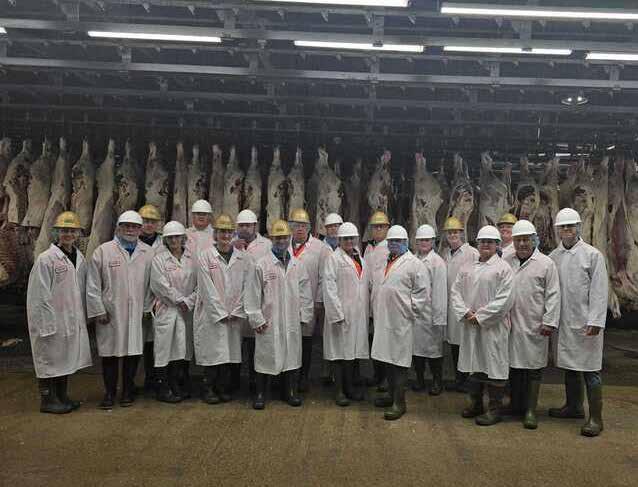
industry challenges. The group then visited Deer Creek Feeding. In the words of owner Justin Ball, Deer Creek Feeding serves as a “dairy hotel,” with over 85,000 calf hutches. We ended the day with dinner at

Breeder Since
Charolais Breeder Since 1962
Charolais Breeder Since 1962
Ø Bull calves out of HCR Answer HCR SPIRIT 4007.
Ø Bull calves out of HCR Answer 2042 and HCR SPIRIT 4007.
Ø Bull calves out of HCR Answer 2042 and HCR SPIRIT 4007.
Ø Bred for calving ease and growth.
Ø Bred for calving ease and growth.
Ø Bulls for both purebred and commercial breeders.
Ø Bulls for both purebred and commercial
Ø Bred for calving ease and growth.
Ø Yearlings and two-year-olds available.
Ø Yearlings and two-year-olds available.
Ø Bred heifers to calve in fall available.
Ø Bulls for both purebred and commercial breeders.
Ø Bred heifers to calve in fall available.
Ø Yearlings and two-year-olds available.
Tyler’s BBQ in Amarillo, TX, where owner Tyler Frazier met with the group to share his story and mission.
Ø Bred heifers to calve in fall available.
Day two began at West Texas A&M in Canyon, Texas, where we toured the Caviness Meat Science and
John Allison, Owner 545 Eminence Road New Castle, KY 40050 502-220-3170 David

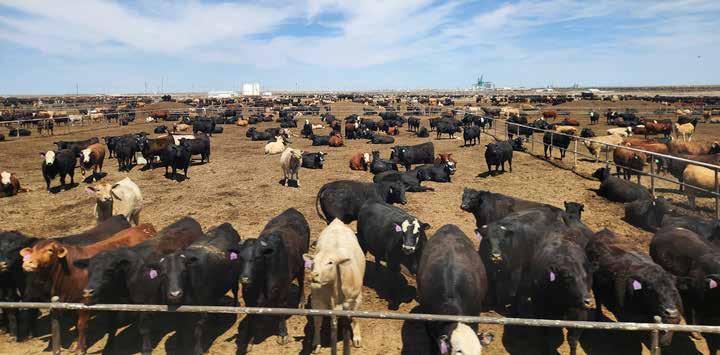
Innovation Center. We also visited Palo Duro Canyon, the second-largest canyon system in the United States, before heading to Matador Ranch in Matador, Texas. Tim Washington, ranch manager, has been with the ranch for over 36 years and shared insights into their cattle and horse operations, as well as the ranch’s history.
On Thursday, the group visited R.A. Brown Ranch in Throckmorton, Texas. Donnell Brown led a tour of the operation. R.A. Brown Ranch is best known for its breeding bulls, selling over 800 annually. The cowherd includes Angus, Red Angus, and SimAngus. The group enjoyed great conversation with Brown over lunch.
We wrapped up the tour at the Fort Worth Stockyards, where we watched the iconic cattle drive and spent time exploring the historic district.
If you’re interested in attending the next Beyond the Bluegrass tour, please contact the KCA office or email info@kycattle.org to be added to the mailing list!
The Kentucky Cattlemen’s Association Hall of Fame is designed to honor a member of the organization that has given time, service, and talent to the betterment of the Cattlemen’s Association at the county and/or state levels. 2025 applications must be postmarked by June 30th. Call us at (859) 278-0899 with questions. Application available at www.kycattle.org/hall-of-fame

* MEMBERSHIP YEAR 10/1/24– 9/30/25
NAME SPOUSE NAME FARM NAME
*Payments of KCA membership dues are tax deductible for most members as an ordinary and necessary business expense. However, charitable contributions of gifts to KCA are not tax deductible for Federal Income Tax purposes. Due to new IRS regulations, $2.24 of your dues would not be deductible. Approximately $12 of your dues will go towards the monthly publication Cow Country.
PLEASE CHECK THE MEMBERSHIP(S) YOU WOULD LIKE TO JOIN:
KCA MEMBERSHIP ($30/YR) NEW RENEWAL
Membership dues are $30 unless otherwise listed below
KCA COUPLE MEMBERSHIP
To add your spouse, please add $15 to your KCA Membership
KENTUCKY JUNIOR CATTLEMEN’S ASSOCIATION ($10/YR) NEW RENEWAL
I WOULD LIKE ADDITIONAL INFORMATION ON THE YOUNG PRODUCER’S COUNCIL
TOTAL MEMBERSHIP:
$ KCA
$ KJCA
TOTAL CONTRIBUTIONS:
$ CATTLEMEN’S FOUNDATION DONATION (voluntary)
TOTAL AMOUNT ENCLOSED:
$ ALL DONATIONS TO KCF ARE TAX DEDUCTIBLE
COUNTY DUES
Dues are $30 except for the counties listed below.
Allen...............................$40
Anderson........................$25
Bourbon.........................$20
Boyle ..............................$35
Bullitt..............................$20
Butler..............................$25
Franklin ..........................$25
Louisville Area ................$20 (Jefferson, & Spencer) Magoffin .........................$20 Menifee ..........................$25
Mountain........................$25
(Breathitt, Floyd, Knott, Lee, Leslie, Letcher, Morgan, Owsley, Perry & Wolfe)
Highlands .......................$20 (Boyd, Johnson, Lawrence, & Martin) Hopkins ..........................$35 Laurel.............................$35
Woodford......................$25
IF YOU WOULD ALSO LIKE TO JOIN THE NATIONAL CATTLEMEN’S BEEF ASSOCIATION The NCBA is now a State Marketing Partner with the KCA. You can pay your dues to both organizations with one check, at the same time.
+

Amelia Carter Director of Industry Relations
BOWLING GREEN, KY - The second session of Beef Advance brought class participants to Region 2 for three packed days of hands-on learning, industry insight and leadership development.
The session kicked off at Oak Hollow Farm, an eighth-generation registered Angus operation. Joe Lowe described how his family utilizes direct marketing, intensive grazing, and genetic selection to build a sustainable and profitable program. He emphasized their goal of producing high-quality beef without compromising structural soundness or maternal traits. Joe also spoke about his experience in NCBA’s Trailblazer program, offering valuable insight into how producers can grow as advocates by sharing their stories and building meaningful connections with consumers.
The group then traveled to CPC Feeds, where Mill Manager Brian Wright led a comprehensive tour of the family-owned feed mill and shared the company’s nearly 50-year history. Participants observed the feed manufacturing process firsthand, gaining insights into how CPC produces a variety of custom rations to meet the nutritional needs of area livestock operations. The tour concluded with a look at their cattle handling setup, where Wright detailed the CPC Value-Added Cattle Program.
That evening, the group enjoyed dinner and ice cream at Chaney’s Dairy Barn. Carl Chaney led a tour of the facilities and shared how the farm has evolved over the years. Participants observed the Lely robotic milking system in action and visited the compost-bedded pack barn, where they saw the Jersey cows up close and gained insight into how the farm's various technology systems support animal care, operational efficiency and product quality. They also toured the processing area, where milk is bottled and turned into ice cream. It was a fitting end to the day, offering a firsthand look at how the Chaney family has built a successful on-farm brand through strategic investment and a supportive community.
Day two began at the Western Kentucky University dairy unit with Jeffrey Bewley of the Holstein Association, who guided the group through a discussion and tour of the WKU SmartHolstein Lab. With an extensive background in research and precision technology, Bewley demonstrated how wearable sensors, feed management systems and other automation tools could be used to support herd health and management. As the group moved through the facility, they saw these innovations in action and discussed how they contribute to early illness detection, improved animal comfort and labor efficiency. While rooted in dairy, the concepts were made highly relevant to beef producers, reinforcing how technology and AI are becoming valuable tools across all segments of livestock production.
The group then visited the Hilltopper Creamery and WKU Farm Market, led by Dan Strunk, Luiz Silva, and Tesla Trammell. Milk from the university’s dairy herd is processed on-site into awardwinning artisan cheeses, and the market also offers dry-aged beef, pork and seasonal produce—all managed with active student involvement from start to finish.
Following the creamery, the group toured the WKU Beef Unit, where Strunk and Tesla highlighted the university’s focus on sustainable production and hands-on learning. The herd is divided into spring and fall calving groups, giving students year-round exposure to real-world herd management. From calving and health protocols to forage-based feeding strategies, the visit showcased how WKU prepares students to be the next generation of beef producers.
After lunch, the group visited the WKU meats lab for a beef fabrication demonstration led by Silva. Participants toured the university’s USDA-inspected facility, including the dry-aging cooler and processing area. Silva walked the group through the breakdown of a rib primal, explaining both the anatomy and the retail value of different cuts. The demonstration concluded with the
retail cuts packaged, labeled and set to appear on the same farm market shelves the group had visited earlier.
Advocacy development continued with Jake Harrod of the Kentucky Beef Network leading a Beef Quality Assurance (BQA) training, emphasizing animal husbandry, producer responsibility and the importance of maintaining consumer trust. Participants who had not yet completed their certification were encouraged to do so as part of their post-session homework. The discussion reinforced that strong advocacy begins with everyday practices on the farm.
The final day began with an educationfocused morning that helped participants better understand how the Beef Checkoff connects with the public. The group first reviewed the Kentucky Beef Council’s marketing plan, which outlined current focus areas, outreach efforts and the strategies used to promote beef across the state. That was followed by a presentation from the National Cattlemen’s Beef Association, where participants heard the latest consumer research and insights into what today’s audiences value, how they make purchasing decisions and the messages that build trust. Together, these sessions provided a clearer picture of how Checkoff dollars are invested and how that work supports the entire industry.
To close out the education sessions, Coach Kiah led an energizing workshop on personal branding and storytelling. She encouraged participants to reflect on their own experiences and think about how they want to be seen as advocates for the beef industry. Through guided discussion and handson exercises, the group explored how authenticity and connection can be powerful tools for building trust with your audience and how each advocate’s voice adds to the broader story of beef.
The final stop of the session brought the group to Pleasant Hill Farms, where they met with the Cowles family, longtime producers known for


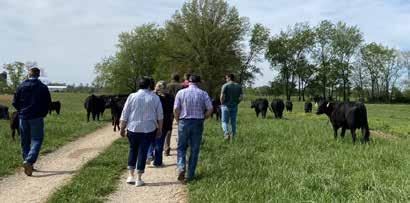



their registered Angus and Simmental seedstock program. Mary Cowles led a tour of their on-farm retail store, The Butcher, The Baker, The Coffeemaker, which is open on Saturdays and offers a curated selection of farm-raised beef, locally sourced pork, baked goods, coffee and Kentucky-made products. Corbin Cowles then invited the group into their sale barn to discuss the
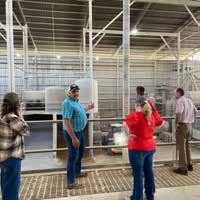
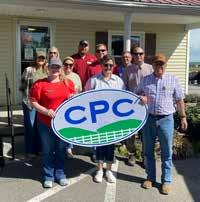
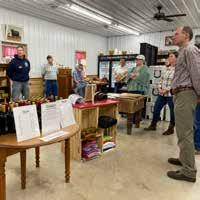



farm’s history, evolving sales model and the family's approach to balancing production with entrepreneurship. The visit offered a firsthand look at how a multigenerational farm can adapt and diversify to meet the needs of both its operation and its community. Each element of the session offered participants a unique perspective of the beef industry and the many roles’

advocates can hold in it. With perfect weather and strong engagement throughout, the participants left energized and looking ahead to Session 3 in Somerset—ready to build on their momentum and continue growing as informed, confident leaders in Kentucky’s beef industry.


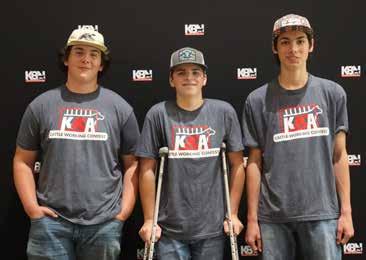



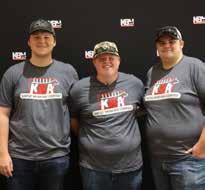
The Kentucky Beef Network and the Kentucky Junior Cattlemen's Association would like to congratulate all the teams that qualified for the state competition of the KJCA Cattle Working Contest. A special congratulations is extended to the top three teams at the state competition: Henry County White, Cultivated Cowpokes and Shelby County. We look forward to hosting the event again in 2026.





Dan Miller Industry Coordinator, Kentucky Beef Network
On April 26 we officially finished our 2025 calving season. It was a tough year to be calving in February, but we do it to ourselves, right?
This year, we had less cows to calve than in recent years. Last September, we pregnancy checked 114 head and ended up with 99 bred females (87% total herd conception). However, given the abnormally dry conditions at that time and the rising cull cow market, we choose to sell some of the older bred cows that had less-than-ideal traits. This ultimately got us down to 82 bred females to calve in 2025.
The heifers started calving first on Feb. 21. We had two of the first five calves born dead, both of which appeared to be very small. We also lost one calf that was born alive, but the heifer laid down and spit him out under a gate onto a sheet of ice. We found him but could not get him warmed up enough, and unfortunately, he perished as well.
Of the 17 first-calf heifers, 13 of them had an AI calf (we AI bred 18 heifers, so that’s 72% AI conception).
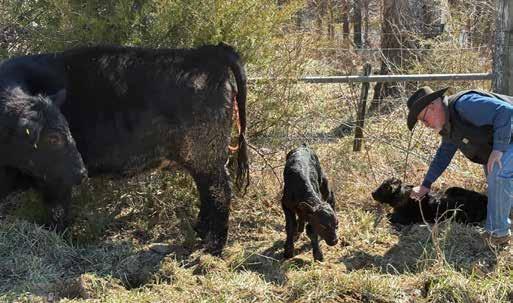
The cows AI conception is not able to be calculated because we sold 16 bred cows, and we do not know how many of them were bred AI. However, we did get 39 AI calves on the ground from the cows. Our calving window continues to be relatively short. If you remember, we keep the cleanup bulls in for just two heat cycles after AI. This gives the cows three chances to get bred. Our total calving season this spring was 64 days. We had 61
calves (75%) in 30 days, 74 calves (90%) in 40 days, and all but two were born in 54 days. In all, we ended up with 39 steers, 36 heifers and one set of twins.
Calving season is always a challenge, but it goes much smoother with good help. I want to thank our Farm Manager Greg Cole for his numerous hours of checking, walking, tagging, feeding and doctoring to get a calf crop on the ground successfully. Without his efforts we wouldn’t be able to do this work at Eden Shale Farm.

Generally the Buyer is responsible for collecting the Beef Checkoff assessment from the Seller

However, both the Buyer and the Seller are responsible for seeing that the Checkoff is collected and paid. or pays $2 to
QUALIFIED STATE BEEF COUNCIL
Cattlemen’s Beef Board invests in national Checkoff programs, while Kentucky Beef Council invests in state programs.
If you are a producer from one of these seven states - Alaska, Connecticut, Maine, Maryland, Massachusetts, New Hampshire, and Rhode Island - you will remit directly to the Cattlemen’s Beef Board. If you have any questions regarding who is responsible for remitting the Checkoff assessment or how to remit payment, please contact your State Beef Council or the Cattlemen’s Beef Board at (303) 867-6304.
3 Exceptions to Beef Checkoff Collection: 1. Non-producer status: If a person (or company) owns cattle for 10 days or less, purchases the cattle to facilitate the transfer of ownership to a third party, and certifies that any Checkoff dollars due from the previous owner have been collected, then that person qualifies as a “Non-Producer” and the Checkoff assessment is not due when qualified cattle are resold. 2. Organic Exemption: In the 2002 Farm Bill, Congress created a process exemptiing organic producers from paying Checkoff program assessments. 3. Pre-Payment: Producers can also choose to “prepay” the Checkoff assessment when shipping cattle out of state for feeding and still retain ownership on the cattle. This allows the producer to direct half of the $1-per-head national Checkoff assessment to the beef council in the state where the cattle were raised, rather than the state where the cattle will be fed. Note: To claim any of these exemptions, the person selling the cattle must provide the proper ‘document’ to show that the Checkoff assessment is not due at the time of sale. Thus, the rule of thumb for all cattle sales is that the person paying the producer should collect either a “Dollar or a Document.”
LIVESTOCK MARKET - When cattle are sold through a livestock market or video market, the Market collects and remits the Beef Checkoff assessment.
CATTLE DEALER/ORDER BUYER - When cattle are sold to a Cattle Dealer or Order Buyer, the Dealer/Order Buyer collects and remits the Beef Checkoff assessment.
ANOTHER PRODUCER - Both the Buyer and the Seller are responsible for making sure that the Beef Checkoff assessment is collected and remitted. For clarity and consistency, we encourage the Seller to take on this compliance responsibility.
VEAL GROWER - When dairy calves are sold to a Veal Grower, both the Buyer and the Seller are responsible for making sure that the Beef Checkoff assessment is collected and remitted. For clarity and consistency, we encourage the Seller to take on this compliance responsibility.
CATTLE SHOWS AND FAIRS - When producers sell their animals at fairs or cattle shows (4H/FFA shows, Purebred cattle shows, etc.), the Organization that runs the sale collects and remits the Beef Checkoff assessment.
FEEDLOT - When cattle are sold directy to a feedlot, the Feedlot collects and remits the Beef Checkoff assessment.
PACKING PLANT - When cattle are sold to a packing plant, the Packing Plant collects and remits the Beef Checkoff assessment.
DIRECT-TO-CONSUMER BEEF SALES - When producers market their cattle as beef, the Producer is responsible for remitting the Beef Checkoff assessment.
According to the Paperwork Reduction Act of
an agency may not conduct or
person is
to a
it
to
The
for this
of
and
control
OMB control
collection is 0581-0093. The time required to complete this
collection is estimated to
per response, including the
one
for reviewing instructions, searching existing data sources, gathering and
the
and completing and reviewing the
of
The U.S. Department of Agriculture (USDA) prohibits discrimination in all its programs and activities on the basis of race, color, national origin, age, disability, and where applicable, sex, marital status, familial status, parental status, religion, sexual orientation, genetic information, political beliefs, reprisal, or because all or part of an individual’s income is derived from any public assistance program. (Not all prohibited bases apply to all programs.) Persons with disabilities who require alternative means for communication of program information (Braille, large print, audiotape, etc.) should contact USDA’s TARGET Center at (202) 720-2600 (voice and TDD). To file a complaint of discrimination, write to USDA, Director, Office of Civil Rights, 1400
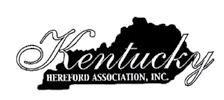
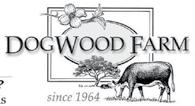
Toby & Debby Dulworth 2492 S. Kirkman Road LaCenter, KY 42056 (270) 224-2993 • dogwood@brtc.net Herefords that thrive on forages. www.dogwoodherefords.com

Codee Guffey • 1815 Grassy Springs Road Versailles, Kentucky 40383 (502) 598-6355 rockridgeherefords@gmail.com www.rockridgeherefords.com
Tony & Kathy Staples 992 Knotts Road Brandenburg, KY 40108 (270) 945-9277 (270) 422-4220
tstaples@bbtel.com
Registered Polled Herefords
HANSELL PILE, JR.
12045 St. John Rd.
Cecilia, KY 42724
270-735-5192
12 miles West of Elizabethtown

Shannon, Kerry, Emily, Will & Ellie Morgan 13095 Scottsville Rd, Alvaton, Kentucky 42122 www.morganandmorganpolledherefords.com Shannon: (270) 320-2389
June 6 & 7 Clark County Fairgrounds Winchester, KY
JNHE “Live from Louisville” July 12-18 Louisville, KY
Kentucky Beef Expo Schedule Friday March 1st - Hereford Show - 1pm Saturday March 2nd - Hereford Sale - 1pm Sunday March 3rd -

Polled Herefords
439 Flatwoods Frozen Camp Rd, Corbin KY 40701
Bobby & Brenda Wells (606) 344-0417 wells_farm@yahoo.com
Polled Herefords
Dale Stith
439 Flatwoods Frozen Camp Rd, Corbin KY 40701
President: Chris Hopper 606-584-7842
Toby & Debby Dulworth 2492 S. Kirkman Road LaCenter, KY 42056 (270) 224-2993 dogwood@brtc.net
Bobby & Brenda Wells (606) 523-0569 or (606) 344-0417 wells_farm@yahoo.com
Kevin, Angela, Kenlea & Kyler Murray (606) 528-1691 or (606) 682-8413
Herefords that thrive on forages. www.dogwoodherefords.com

6077 Helena Road Mayslick, KY 41055
6077 Helena Road Mayslick, KY 41055
Charlie Boyd II 606-584-5194
Charlie Boyd II 606-584-5194
Annual Bull Sale second Saturday in March Hereford and Angus Bulls
Annual Bull Sale second Saturday in March Hereford and Angus Bulls
5239 Old Sardis Pike Mays Lick, KY 41055 dalestith@yahoo.com (918) 760-1550
Kevin, Angela, Kenlea & Kyler Murray (606) 528-1691 or (606) 682-8413

Registered Polled Herefords
Registered Polled Herefords
PAUL L. HANCOCK 8559 KY 56 Owensboro, KY 42301 270-771-4194
PAUL L. HANCOCK 8559 KY 56 Owensboro, KY 42301 270-771-4194
Secretary/ Treasurer: Melinda Watson 859-625-8660 melindawatson8660@gmail.com
• 859-779-1419 Secretary/ Treasurer Melinda Watson • 859-625-8660 melindawatson8660@gmail.com
K3 CATTLE REGISTERED HEREFORDS
K3 CATTLE REGISTERED HEREFORDS
KYLE BUSH
K3CATTLE@YAHOO.COM 859-588-4531
KYLE BUSH K3CATTLE@YAHOO.COM 859-588-4531
198 HICKS PIKE CYNTHIANA, KY 41031
198 HICKS PIKE CYNTHIANA, KY 41031

Polled Hereford and Gelbvieh Cattle 3459 KY Hwy. 1284 E. Cythiana, KY 41031 (859) 234-6956
Polled Hereford and Gelbvieh Cattle 3459 KY Hwy. 1284 E. Cythiana, KY 41031 (859) 234-6956
Ben, Jane, Shelby and Lincoln
Hereford Farms
Brad, Carla, Clay & Clint Chambliss 1101 Driftwood Lane
Elizabethtown, KY 42701
Brad, Carla, Clay & Clint Chambliss 1101 Driftwood Lane Elizabethtown, KY 42701 Home (270) 982-3905 Cell (270) 668-7126 fax 270-735-9922
Home (270) 982-3905
Cell (270) 668-7126 fax 270-735-9922

Registered Polled Herefords PO Box 215 Cross Plains, TN 37049 615-478-4483
Registered Polled Herefords PO Box 215 Cross Plains, TN 37049 615-478-4483
billymjackson@aol.com
billymjackson@aol.com
Eric & Ronnie Thomas 2396 Union City Rd. Richmond, KY 40475 (859) 623-5734
Eric & Ronnie Thomas 2396 Union City Rd. Richmond, KY 40475 (859) 623-5734
Eric’s Cell (859) 314-8256
Eric’s Cell (859) 314-8256
“Cattle for sale at all times”
“Cattle for sale at all times”
Jackie D. Perkins II 367 Mt. Pisgah Rd. Bremen, KY 42325 (270) 543-3586
Jackie D. Perkins II 367 Mt. Pisgah Rd. Bremen, KY 42325 (270) 543-3586
Breeding to produce good cows since 1981
Breeding to produce good cows since 1981
Tony Brandenburg, tstaples@bbtel.com
Ben, Jane, Shelby and Lincoln TK4
www.chamblissherefordfarms.com
www.chamblissherefordfarms.com
“Farming the Same Land Since 1834”
“Farming the Same Land Since 1834”

WCN Polled Herefords
Registered Polled Herefords Bulls & Females for sale
Since 1961
Tim & Peggy Wolf
Bill Norris 2220 Celina Road
12939 Peach Grove Road Alexandria, KY 41001
Burkesville, KY 42717
Home: 859-635-0899 Cell: 859-991-3484
Phone (270) 433-7256
Cell (270) 433-1525
“Every calf needs a white face”

Peyton’s Well Polled Herefords The Lowell Atwood Family 133 Edgewood Drive • Stanford, KY (606) 365-2520 home/fax (606) 669-1455


Registered Polled Herefords
BECKLEY HEREFORDS
Bulls & Females for sale
Tim & Peggy Wolf 12939 Peach Grove Road
L. Wayne Beckley • 1420 Fitchburg Rd. Ravenna, KY 40472 • 606-723-3021 Cell: 859-779-0962
Alexandria, KY 41001
Home: 859-635-0899
Cell: 859-991-3484
L.W. Beckley D.V.M 284 Pyrse Lane • Irvine, KY 40336 Cell: 859-779-1419 • Clinic: 606-726-0000 www.beckleyherefords.com

L. Wayne Beckley • 1420 Fitchburg Rd. Ravenna, KY 40472 • 606-723-3021 Cell: 859-779-0962
L.W. Beckley D.V.M
284 Pyrse Lane • Irvine, KY 40336
Cell: 859-779-1419 • Clinic: 606-726-0000 www.beckleyherefords.com
“Breeding Polled Herefords for over 58 Years” Breeding cattle for sale at all times. 1999 Walnut Hill Rd. Lexington, KY 40515 (859) 271-9086 cell (859)533-3790
WATSON LAND & CATTLE
Flemingsburg,
CATTLE FOR SALE AT ALL TIMES
Tucker Stock Farms
“Registered Angus and Polled Herefords”
“Breeding Polled Herefords for over 58 Years” Breeding cattle for sale at all times.
John Tucker II 1790 Hidden Valley Lane Hudson, KY 40145 270-617-0301
1999 Walnut Hill Rd. Lexington, KY 40515 (859) 271-9086 cell (859)533-3790 Tucker
“Bulls always for Sale”

BOYD BEEF CATTLE
6077 Helena Road
Mayslick, KY 41055
Charlie Boyd II: (606) 584-5194
Blake Boyd: (606) 375-3718 www.boydbeef.com cboyd2@maysvilleky.net
BURTON & SONS ANGUS
Joe D. or Karen Burton

927 Old Liberty Pike • Hustonville, KY 40437 (859) 238-0771 • www.branchviewangus.com
James S. & LuAnn Coffey, Donald & Donna Coffey
Annual Production Sale- 2nd Saturday in April

480 Hominy Hill Rd. Nancy, KY 42544
Joe: (606) 305-3081
Located 15 miles West of Somerset • klburton01@windstream.net
Bulls & females sold private treaty. Inquiries Welcome. Sell only what we would buy. Data driven since 1981.
FALL CREEK ANGUS
448 Corder Farm Road
Monticello, KY 42633
Ronnie Corder (606) 348-6588
HILL VIEW FARMS
Jimmy Gilles
5160 Lee Rudy Road Owensboro, KY 42301 (270) 929-5370 jcgilles86@gmail.com
APS ANGUS
4040 Taylorsville Rd
Taylorsville, KY 40071
Gordon Schubert
502-477-2637 • 502-548-8440
Anne Patton Schubert 502-477-2663 • 502-548-2359

TWIN CREEK FARM
HILL VIEW FARMS
Vice
Secretary/Treasurer:

COFFEY ANGUS FARMS
661 Hopewell Road Liberty, KY 42539
Matt Coffey: (270) 799-6288
Dewey Coffey: (606) 706-2699
BURKS CATTLE CO. 531 Rick Rd.
Park City, KY 42160
Eddie Burks • (270) 991-6398 www.burkscattle.com

Bardstown Rd Springfield KY 40069 573-721-6663
DUTCH CREEK ANGUS FORAGE GENETICS
Doug and Susan Schlosnagle (502) 706-0008
BURTON & SONS ANGUS Joe D.
Genetics for Maximum Profitability since 1984

DutchCreekAngus.om

GREAT MEADOWS ANGUS ASSOCIATION
Dale Brown, President
COFFEY ANGUS FARMS
661 Hopewell Road Liberty, KY 42539
292 Pea Ridge Road Stamping Ground, KY 40439 859-940-8437 www.greatmeadowsangus.com
Matt Coffey: (270) 799-6288

www.mtmoriahangus.com
HERITAGE FARM
Tom McGinnis
1024 Hinkle Lane • Shelbyville, KY (502) 633-1634, home (502) 633-5100, work (502) 655-0164, cell
KINGS ANGUS 250 Bright Leaf Dr. • Harrodsburg, KY 40330
Cary & Kim King
Carymking@yahoo.com • fourkingsangus.com
jacob.tamme@gmail.com www.tammevalley.com

SALES: 3rd Saturday in October • 4th Saturday in April
Dewey Coffey: (606) 706-2699
Genetics for Maximum Profitability since 1984
DAVIS BEND FARMS
LYNN CREEK FARMS
2315 Davis Bend Road Canmer, KY 42722
Kris and Sara Lynn 2184 Bardstown Rd Springfield KY 40069 573-721-6663
timmothyljeffries@gmail.com www.davisbendfarms.com
Tim: (270) 528-6605 • Leslie: (270) 528-6435

FALL CREEK ANGUS
SMITHLAND ANGUS FARM
4437 East Hwy 80 Russell Springs, KY 42642
Cary Cell: (859) 613-3734 • Colby Myers - Purebred Manager
OLD BARK FARM
OLD BARK FARM
370 Ferrill Hill, Buffalo, KY 42716
Nathaniel(Bub), Sarah, (606) 423-2457 • (606) tripledangus.com
370 Ferrill Hill, Buffalo, KY 42716
Kenley Conner (502) 905-7825
Kenley Conner (270) 735-5324
Registered Angus Cattle TWIN CREEK FARM Shawn, Melissa, Devin (270) 337-3072 or Dennis & Emily 270/337-2128 or
Registered Angus Cattle
448 Corder Farm Road Monticello, KY 42633 Ronnie Corder (606) 348-6588 4040 Taylorsville Rd
Henry Bryan, Melissa, Bryanna and Blane Smith 606-271-7520 bmsmith@duo-county.com
HAMILTON ANGUS FARMS
Eddie Hamilton 2142 Stilesville Road Science Hill, KY 42553 edjohami@aol.com (606) 271-1286 Bulls and Females for Sale
PLEASANT HILL FARMS
PLEASANT HILL FARMS

TRIPLE D ANGUS
Nathaniel & Darla Denham

Nathaniel(Bub), Sarah, Ashley Denham (606) 423-2457 • (606) 875-0780 tripledangus.com
CANNON ANGUS
509-5401 whitefarm4@twc.com
Shawn, Melissa, Devin & Dylan Gibson (270) 337-3072 or (270) 692-5304 Dennis & Emily 270/337-2128 or 270/402-4338
Jimmy Gilles 5160 Lee Rudy Road Owensboro, KY 42301 (270) 929-5370 jcgilles86@gmail.com

RANDOLPH FARM
JOHNSON FARMS ANGUS
Angus Bulls & Females Slaughters, KY
6550 Highway 330 Owenton, KY 40359 Carter Randolph: (513) 543-4343 Nick Sarky: (513) 262-9846 patty@randolphfarmoperations.com Bulls Available

Gil, Mary, Corbin, Caroline, and Catherine Cowles 500 Rockfield Richpond Road Rockfield, KY 42274 (270) 843-9021 • Fax (270) 843-9005
HERITAGE FARM

Located 7 miles west of Bowling Green, 1/2 mile off Hwy 68/80
Gil, Mary, Corbin, Caroline, and Catherine Cowles 500 Rockfield Richpond Road Rockfield, KY 42274 (270) 843-9021 • Fax (270) 843-9005 Located 7 miles west of Bowling Green, 1/2 mile off Hwy 68/80
Tom McGinnis 1024 Hinkle Lane • Shelbyville, KY (502) 633-1634, home • (502) 633-5100, work (502) 655-0164, cell
Mary Jayne and Victoria Cannon 4619 Cherry Grove Rd Flemingsburg, KY 41041 606-748-5420 www.cannonangusfarm.com


TAMME VALLEY FARM
Keith: (270) 635-0723 Reese: (270) 635-1137 SMITHLAND ANGUS FARM 5202 East Hwy 80, Russell Springs, KY
Jacob Tamme, Owner-Operator (859) 583-7134 jacob.tamme@gmail.com www.tammevalley.com & Find us on Facebook!
Charles “Bud” & Pam Smith: (270) 866-3898 Henry & Melissa Smith: (270) 866-2311
KENTUCKY ANGUS ASSOCIATION MEMBERSHIP APPLICATION

Return to: Shayna Gibson 1535 Fallen Timber Road New Castle, KY 40050 • Annual Dues $35
Shayna Gibson, Secretary/Treasurer
www.kentuckyangus.org • kyangusassociation@gmail.com • @kyangusassoc • @kyangusassoc • @kyangusassociation
2025 KENTUCKY ANGUS PREVIEW SHOW
June 12-13, 2025
Kentucky Fair & Exposition Center Louisville, Kentucky
Tentative Schedule
Wednesday, June 11
After 9 am
Barn available; tie in pavilion
Thursday, June 12
10:00 am to 12:00 pm
Check in All Cattle 3:00pm
KJAA Board meeting and Social
Friday, June 13
9:00 AM
Phenotype/Genotype Show Jon Davis
Following Phenotype/Genotype Show
Kentucky Preview Junior Show Jon Davis
Immediately after Kentucky Preview Junior Show Junior Showmanship
Show Order PGS Steers
Cow/Calf Pairs
Bred & Owned Bulls
Bred & Owned Heifers
Owned Heifers
2025 PREVIEW DONATION FORM
New Castle, KY 40050 NAME
Please remit check made payable to the Kentucky Angus Association to the following address prior to May 15th: KAA 1535 Fallen Timber Road

KEVIN AND RACHEL BARRON
Crestwood, Ky (502) 905-5851
rkbarron812@gmail.com

SWAIN SELECT SIMMENTAL 12113 Green Valley Dr. Louisville, KY 40243 swainselect.com swainselect@gmail.com facebook.com/swainselectsimmental Fred & Phyllis: 502-599-4560 Chi & Angie: 502-287-2116


JUDY AND RONDAL DAWSON 1156 Buzzard Roost Road Shelbyville, KY 40065 502-593-5136 • jrdawson22@outlook.com

JEROD METZGER • 270-779-6260

ROCKING P LIVESTOCK 8308 Orangeburg Road Maysville, KY 41056
Chan: 606-584-7581
Keith: 606-584-5626 rockingplivestock@maysvilleky.net
BRIAN & HEATHER SWAIN 3906 Pottertown Road Murray, KY 42071 • 270-293-4440
wksbswain@murray-ky.net


SIMMENTAL AND SIMANGUS BULLS FOR SALE
1939 Huntertown Road
Versailles, KY 40383
BULLS FOR SALE
Chris Allen 859-351-4486 callenuky@hotmail.com
Dr. Henry Allen 859-229-0755


The Simmental cow can handle any environment.
She’s built to last in heat, fescue or high altitudes. And thanks to the breed’s built-in adaptability, you can match Simmental genetics to your environment – SimAngus,™ SimAngus HT, Simbrah or proven Simmental genetics.
Meet America’s all-purpose cow – gentle and consistent, with calves that give the heterosis boost commercial cattlemen need to stay profitable.
406-587-4531 • simmental.org

BRET AND LAURA JACKSON 859.533.3718 or 859.707.7200
BRET & LAURA JACKSON Paris, Kentucky (859) 533-3718 (859) 707-7200

AA LAND & CATTLE
Daryl Derossett, President..................................................................................................................(270) 670-6232
Registered Gelbvieh & Balancers
Cynthiana, KY
LARRY CLARK & SONS LLC
Johnnie Moore, Vice President...........................................................................................................(270) 670-7814
Luke Arthur (859) 298-8323
Registered Gelbvieh Cattle
106 Clark Houk Road • Greensburg, KY 42743
Pat Tilghman, Secretary/Treasurer.......................................................................................................(270) 670-8449
luke.arthur93@gmail.com
Bulls • Show Prospects • Embryos Bulls sell with GE EPD’s • Show Prospects
IV
Larry Clark, Owner & Operator (270) 299-5167 • (270) 405-6848
Lpclarkandsons@msn.com
Barry, Beth & Ben Racke • Brad Racke • 7416 Tippenhauer Rd. • Cold Spring, KY 41076
BAR IV LIVESTOCK
Phone (859) 635-3832 • Barry cell (859) 991-1992 • Brad cell (859) 393-3677 • Ben cell (859) 393-3730 Fax (859) 635-3832 • bar4@twc.com
Barry, Beth & Ben Racke • Brad Racke
7416 Tippenhauer Rd. • Cold Spring, KY 41076
Phone (859) 635-3832 • Barry cell (859) 991-1992
Brad cell (859) 393-3677 • Ben cell (859) 393-3730 Fax (859) 635-3832 • bar4@twc.com
Niles & Betty K Bray • 1568 Bray Ridge Road Bedford, KY 40006 • (502) 255-3584
BEE LICK GELBVIEHS
CD FARMS
Eddie Reynolds 277 Old Bee Lick Rd. Crab Orchard, KY 40419
606-379-2281(H) 606-305-1972(C)
Clayton & Debbie Cash 1214 Ottawa School Road • Brodhead, KY 40409 (606)-308-3247 • (606)-758-8994
Bulls & Females for sale

CLIFFORD FARMS
3459 KY HWY 1284E
Cynthiana, KY 41031
Since 1937 (859) 234-6956
Owner/Manager
GELBVIEH/BALANCERS
2050 Glasgow Road Burkesville, KY 42717
Gelbvieh-Balancer Bulls & Heifers For Sale by Private Treaty
Owner/Manager
GELBVIEH/BALANCERS
2050 Glasgow Road • Burkesville, KY 42717
Brian, Lauren, Kristen Barry, Emily & Julia (270) 864-5909 FULL CIRCLE FARMS
Registered Gelbvieh Cattle
Brian, Lauren, Kristen Barry, Emily & Julia • (270) 864-5909
PLEASANT MEADOWS FARM
CD FARMS
Clayton & Debbie Cash 1214 Ottawa School Road Brodhead, KY 40409 (606)-308-3247 • (606)-758-8994
Brad Burke 989 Metcalf Mill Road • Ewing KY 41039 (H) 606-267-5609 • (C) 606-782-1367 gbb789@windstream.net
Gary & Pat Tilghman • Carrie & Daryl Derossett Family • Lindsey & Garland Gilliam Family 690 Lick Branch Road Glasgow, KY 42141 270.646.7024 • pleasantmeadowsfarm@hotmail.com Registered Gelbvieh & Angus cattle for sale
R&D OWEN FARMS
Gelbvieh-Balancer Bulls & Heifers For Sale by Private Treaty
AA LAND & CATTLE
East Bernstadt, KY
606-843-6583
cell 606-309-4662



Black Replacement Heifers & Bulls Available Embryo transplant & AI sired calves
GELBVIEH & BALANCERS PO Box 781 • Eddyville, KY 42038 (270) 601-6830 • rdowenfarms.com • sales@rdowenfarms.com
Johnnie
Registered Gelbvieh & Balancers Cynthiana, KY Luke Arthur (859) 298-8323 luke.arthur93@gmail.com
LARRY CLARK & SONS LLC
MOCKINGBIRD HILL FARMS
Pat
DONE WRIGHT CATTLE FARMS
Saturday May 15
Bulls • Show Prospects • Embryos Bulls sell with GE EPD’s • Show Prospects
Casey Wright, Owner 2665 Poplar Corner Road • Lebanon, Kentucky 40033 270-692-7496 * donewrightcattle@hotmail.com
Kentucky Junior Gelbvieh Show & Learning Clinic
ASHWOOD SPRING GENETICS
BAR IV LIVESTOCK
Registered Gelbvieh Cattle
Registered Gelbvieh Cattle 106 Clark Houk Road • Greensburg, KY 42743
Larry Clark, Owner & Operator (270) 299-5167 • (270) 405-6848 Lpclarkandsons@msn.com
BRIAN W. DYER, DVM
Shane Wells 10172 Provo Rd. Rochester, KY H: 270-934-2198 C: 270-791-8196 swells@logantele.com
Owner/Manager

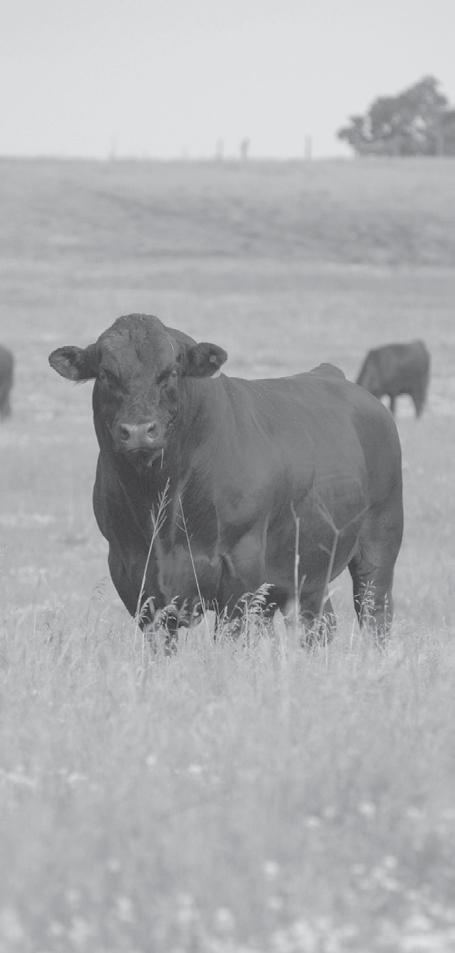
McIntosh Brothers Farm • 3348 Frankfort Road • Georgetown 10AM Learning Clinic • 12:30PM Show
S&S GELBVIEH
Barry, Beth & Ben Racke • Brad Racke 7416 Tippenhauer Rd. • Cold Spring, KY 41076 Phone (859) 635-3832 • Barry cell (859) 991-1992 Brad cell (859) 393-3677 • Ben cell (859) 393-3730 Fax (859) 635-3832 • bar4@twc.com
BREEDING RED & BLACK POLLED GELBVIEH SINCE 1982
Luke & Lindsay Arthur Cynthiana, KY
GELBVIEH/BALANCERS 2050 Glasgow Road Burkesville, KY 42717
859-298-8323
Call William McIntosh for more information. (502) 867-3132
David, Jerri & Jon David: 162 Hastings Ln • Fredonia, KY 42411 (270) 556-4259 Arthur & Joyce Slaughter 19068 Marion Rd • Fredonia, KY 42411 (270)545-3455
Friday May 28 - May 30
AGJA Eastern Regional Junior Show “Run for the Roses” Burley Fields Livestock Center • 709 Oil Fields Road • Horse Cave
Cattle for sale at all times.
CLIFFORD FARMS 3459 KY HWY 1284E Cynthiana, KY 41031 Since 1937 (859) 234-6956
Brian, Lauren, Kristen Barry, Emily & Julia (270) 864-5909

FULL CIRCLE FARMS REGISTERED GELBVIEH CATTLE
BAR IV LIVESTOCK
BEE LICK GELBVIEHS
FULL CIRCLE FARMS
BRIAN W. DYER, DVM
Call Carrie Derossett for more information. (270) 404-0828
Eddie Reynolds
Barry, Beth & Ben Racke • Brad Racke 7416 Tippenhauer Rd. • Cold Spring, KY 41076
Brad Burke: 989 Metcalfe Mill Rd, Ewing, KY 41039 (H) 606-267-5609 (C) 606-782-1367 gbb789@windstream.net
277 Old Bee Lick Rd. Crab Orchard, KY 40419
Phone (859) 635-3832 • Barry cell (859) 991-1992
Entry and room information available at www.gelbvieh.org (Juniors/Regional Shows/AGJA Eastern Regional)
606-379-2281(H) 606-305-1972(C) Bulls & Females for sale
Brad cell (859) 393-3677 • Ben cell (859) 393-3730 Fax (859) 635-3832 • bar4@twc.com
Registered Gelbvieh Cattle
PLEASANT MEADOWS FARM
Owner/Manager
Gary & Pat Tilghman

GELBVIEH/BALANCERS 2050 Glasgow Road Burkesville, KY 42717
Lindsey Tilghman Jones Family
Brad Burke 989 Metcalf Mill Road • Ewing KY 41039 (H) 606-267-5609 • (C) 606-782-1367 gbb789@windstream.net
Carrie & Daryl Derossett Family 690 Lick Branch Road Glasgow, KY 42141 270.646.7024 • pleasantmeadowsfarm@hotmail.
HEDGESPETH LIVESTOCK GELBVIEH/BALANCER CATTLE-COMMERCIAL HEIFERS 543 Pleasant Run Church Road • Campbellsville, KY 42718 sam.hedgespeth@gmail.com • Sam-270.299.5449 Seth-270.932.1615 Dan-606.686.1679 Andrew-270.405.1990
BEE LICK GELBVIEHS
Eddie Reynolds
PADON FARMS
277 Old Bee Lick Rd. Crab Orchard, KY 40419
Brian, Lauren, Kristen Barry, Emily & Julia (270) 864-5909

FULL CIRCLE FARMS
RICH HILL GELBVIEH
Registered Gelbvieh Cattle
Frank McAninch 1341 Iven Godby Road Liberty, KY 42539
606-379-2281(H) 606-305-1972(C) Bulls & Females for sale
GELBVIEH BULLS & FEMALES FOR SALE 1012 Shelby Road • Salem, KY 42078 Thad Padon (270) 836-5518
CD FARMS
BRAY’S GELBVIEH CATTLE
Clayton & Debbie Cash 1214 Ottawa
Niles & Betty K Bray
1568 Bray Ridge Road Bedford, KY 40006 (502) 255-3584
Brad Burke 989 Metcalf Mill Road • Ewing KY 41039 (H) 606-267-5609 • (C) 606-782-1367 gbb789@windstream.net
606-787-0120 richhillfarm@windstream.net

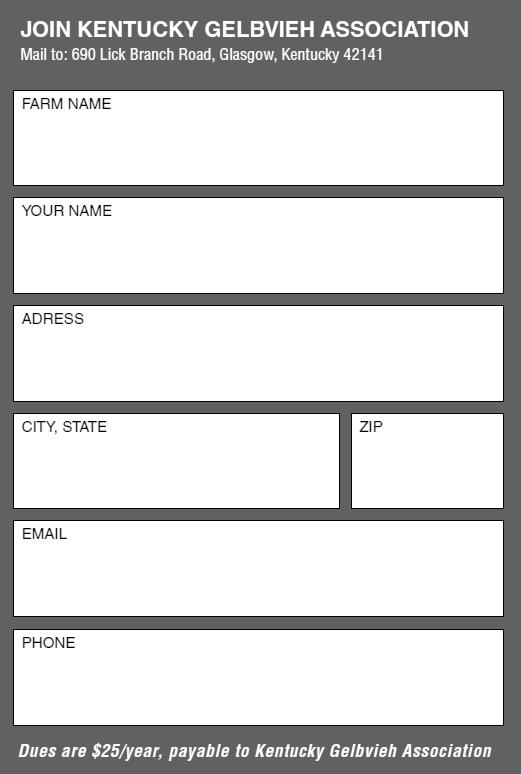
JUN
JUN
JUN

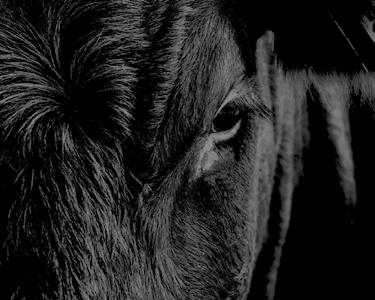
RED
BULLS FOR SALE * FREE DELIVERY *
FOUR WINDS FARM
ew Castle, Kentucky (502) 296-1044
POLLED HERFORD BULLS FOR SALE
19–20-month-old Polled Hereford bulls. Good selection. Low birthweight, medium frame. Free Delivery Available. JMS Polled Herefords, Knifley, KY Danny 270-566-2694 Trent 270566-2000
THE FOUNDATION SALE XI SAT. SEPT. 20, 2025 1 PM CT. UNITED PRODUCERS, Bowling Green,KY • Limousin Fullblood, Purebreed, Limflex. for Info. Call Stephen Haynes 270799-8685 or 270-799-8684
REGISTERED BLACK SIMMENTAL BULLS
Many blaze faced. Excellent EPD’s. Semen Tested. Delivery Available. Maximize your profit with proven performance. All bulls qualify for new CAIP cost-share. Adam Wheatley 502349-2665
DIAMOND J SALERS
Donald Johnson • 11660 N. Hwy 1247 • Eubank, KY 42564 606-379-1558
DIAMOND J SALERS
WILLIS FARMS
Donald Johnson • 11660 N. Hwy 1247 • Eubank, KY 42564 606-305-8747
Danny Willis • 964 Johnson Rd • Frankfort, KY 40601 • 502-803-5011 drwc21@aol.com • Purebred + Optimizer Breeding bulls & Heifers for sale.
DEL-SU FARM
WILLIS FARMS
Howard & Sue Edwards • 420 Rose Rd • Somerset, KY 42501 606-679-1675 • Jeriah Privett • 606-416-1154
Danny Willis • 964 Johnson Rd • Frankfort, KY 40601 502-803-5011 • drwc21@aol.com
KNOB LICK FARM - BULLS & HEIFERS FOR SALE
Larry Cox • Tina Cox-Lynch • Amanda Cox Gibson • 1315 Knob Lick Road • Irvine, KY 40336 • 606-723-3077 • 606-975-1716
BREEDING AGE HEREFORD BULLS FOR SALE AT ALL TIMES Over 60 years of Line 1 Hereford Genetics. Groups of open and bred heifers available for sale at all times.
Chambliss Hereford Farms. 270-668-7126
RED ANGUS, SIMANGUS, CHAROLAIS, ANGUS FOR SALE Red Hill Farms, Lafayette, TN, 615-666-3098 Bart, Sarah and Ty Jones
Gordon and Susan Jones, 270-991-2663
Visit us online - www.RedHillFarms.net
Contact us for cattle and semen availability. Annual Production Sales: More Than a Bull Sale – 3rd Saturday in March • Maternal Monday – 3rd Monday in May • Bulls & Females of Fall Sale – Last Saturday in October
John Deere 7320 cab loader 4WD - $60,000
H&S 310 spreader top feeder - $13,500
Rental- on commercial manure spreaders
Truck mount meyer 700- twin screw on a truck
TMR mixers- parts in stock
Meyer 4516 forage box- $$$$
Tubs- rims/ tires- knives- planetary fluids
S B 200 Artex manure spreader- $39,000
Meyer and Cloverdale TMR mixers in stock
Zero down $$$$ for 11 months
Kubota 90 skid lo
Esch 12 ft drill $$$$$ drill time
Meyer 4618- silage wagon-super clean $26,500
JD 567- string -$19,995
New Holland BR 7060-string - $11,995
Farmco feeders- in stock
JD 5420- 4wd canopy- loader $26,500
JD 6715- 2wd canopy- 16 PS- $$$$
Meyer tmr truck $122,000
Esch 4218/22 tedder $$$ save
CALL CHARLIE FOR A HOT DEAL TODAY!!!!
859-608-9745
REGISTERED ANGUS BULLS, COWS AND PAIRS February yearling bulls • Semen checked, birth weights and EPDS • Calving Ease & Growth, BQA • Metropolis, IL, 618638-7693, www.bremerbrothers.com
BULLS FOR SALE Angus and Lim-Flex Yearlings to 2-year-olds • Delivery available Call or text 270-589-7999
REGISTERED ANGUS BULLS FOR SALE
Yearlings and 2-Year-Old + • Private Treaty Sale Book @ angus.org • Semen Checked & EPDs Available • Randolph Farm, Owenton, KY (513) 262-9846
PERFORMANCE TESTED PUREBRED ANGUS BULLS FOR SALE Call 270-202-7186 for more info or check out www.oakhollowangus.com for current availability.
$15 FOR FIVE LINES OR GET A BOX THIS SIZE FOR $105
CALL KATIE PRATT (859) 278-0899

Do you know what is in your pasture?
Katie VanValin Assistant Extension Professor
Fescue toxicosis has been estimated to cost the U.S. beef industry $1 billion each year. The cause of fescue toxicosis is a fungal endophyte that lives inside tall fescue and produces a family of compounds known as ergot alkaloids that are responsible for the range of symptoms collectively known as fescue toxicosis. The impacts of fescue toxicosis can be felt throughout Kentucky’s beef industry from reproductive impacts in the cow-calf sector to poor growth in the stockers. The classic signs of fescue toxicosis include a retained winter hair coat and cattle standing in ponds or puddles to try and stay cool.
For decades, researchers throughout the Fescue Belt have studied fescue from documenting the early reports of livestock having poor gains and unthrifty appearances to determining the presence of the endophyte and identifying ergot alkaloids as the causative compounds. Understanding the cause of fescue toxicosis has also allowed researchers to seek solutions. Outcomes of these efforts include the development of novel endophyte varieties. These varieties allow the plant to benefit from the presence of the endophyte without producing ergot alkaloids that harm the animals and recommendations like interseeding clover. While there are approaches minimize the risk of fescue toxicosis, there is no single, silver bullet solution. Research
continues to find solutions that could be easily and economically adopted on farm.
In my work as an extension specialist, I have many conversations with producers surrounding fescue, and it is apparent that some herds and operations are more severely impacted than others. At the same time, I recognized that great effort is placed on creating the proper conditions to create fescue toxicosis in a research setting, because after all it is hard to study something that doesn’t occur. Looking back through all the research that has been published about fescue toxicosis, I noticed that a survey of beef cattle pastures was lacking. Perhaps the reason some herds have less of an impact of fescue toxicosis is in part related to greater species diversity and lower ergot alkaloid concentrations. This got me wondering about what is the typical pasture composition and fescue toxicosis risk of a Kentucky beef cattle pasture?
Last summer, the University of Kentucky Beef Extension Team began efforts to identify fescue risk of beef cattle pastures. Surveying pastures includes determining the species present in the pasture- including things like weeds or bare soil. Next, samples were collected from fescue plants throughout the pasture which
were used to determine the presence of the fungal endophyte and the level of ergot alkaloids present at the time of sampling. From this, we can estimate ergot alkaloid consumption by the animals. It is important to note that ergot alkaloid production fluctuates significantly throughout the year but peaks in May-June, so samples were collected from MayJuly.
Last year, we surveyed 18 fields from eight Kentucky farms. The botanical composition of these pastures can be seen in Table 1.
These same pastures had ergovaline (the predominant ergot alkaloid in fescue) concentrations ranging from below the detectable limit (< 100 ppb) to 1,005 ppb. To give context, research has suggested that 100-300 ppb ergovaline in the total diet of cattle can result in fescue toxicosis, while other studies suggest higher concentrations such as 750 ppb may be required. When interpreting ergovaline concentrations, it is important to put it into context of the botanical composition of the pasture. Since these fields were not monocultures, cattle are consuming more than the ergovaline containing fescue. After accounting for pasture composition, estimated ergovaline consumption decreased on average by 57.4% compared to the reported values in the fescue samples.

Based on the guidelines for fescue toxicosis, these pastures were grouped into four risk levels:
• Low risk (< 100 ppb ergovaline; 38.9% of fields)
• Potential risk (100-300 ppb ergovaline; 27.8% of fields)
• Moderate risk (300-750 ppb ergovaline 33.3% of fields)
• High risk (> 750 ppb ergovaline; 0% of fields).
It is important to note that this approach provides only a snapshot in time, as both botanical composition and ergot alkaloid concentrations fluctuate with the seasons. Additionally, we can’t control for animal grazing preference. However, this can give an idea of what is present in the pasture and can certainly provide valuable information. Future work in this area will include looking at pastures throughout other times of the year, as a secondary spike in ergot alkaloids occurs in the fall.
Care should be taken when collecting fescue samples for ergovaline testing, as concentrations can be rapidly degraded after collection. Also, testing can be expensive, so careful planning is recommended to ensure best use of resources. If you have additional questions regarding fescue toxicosis or pasture sampling, please reach out to your county extension office.
• Cows should be on good pasture with clover and preferably low endophyte levels in fescue for the spring breeding season. Keep pastures vegetative by clipping or making hay. They should have abundant shade and water. Our goal is to have cows become pregnant before July when temperatures and heat stress can ruin the “spring” breeding season. Several supplement options are available if your pastures are low in red clover and heat stress appears to be an issue. Contact your agriculture and natural resources extension agent for more information.
• Observe the cows and bulls as the breeding season continues. Watch bulls for injury or lameness and change bulls if a high percentage of cows are returning to heat. Record cow breeding dates to determine next year’s calving dates and keep records of cows and bulls in each breeding group.
• Keep a good pasture mineral mix, which contains adequate levels of phosphorus, vitamin A, selenium and copper, available at all times.
• Consider a special area for creep grazing calves, or practice “forward grazing” this summer, allowing calves to graze fresh pasture ahead of the cows. This can be accomplished by raising an electric wire or building a creep gate.
• Pregnancy test cows if not done previously.
• Cull cows at weaning time
- Smooth-mouthed cows
- Cows weaning light weight and/or poor-quality calves
- Open cows
- “Problem cows” with bad feet, teats, udders, etc.
• Select replacement heifers on the basis of:
- temperament
- conformation
- weaning weight
- dam and sire records
- Select more than needed to allow for culling after a short breeding season
General
• Finish harvesting excess pasture as hay soon! It should be cut before it becomes too mature. Be sure and replenish your reserves. Try to put up more than you think you will need in case of a late summer drought.
• Pasture should supply adequate energy, protein and vitamins at this time. However, be prepared for drought situations. Don’t overgraze pastures so that recovery time will be faster. Overgrazed pastures will recover very slowly during July/August.
• Keep pastures small for rotational grazing so that nutritive quality can be maintained. They should be small enough so cattle do not graze longer than a week. As the season progresses, you need several paddocks to give each properly stocked pasture about four weeks rest.
• Maintain a clean water supply and check it routinely. Water is extremely important in hot weather.
• Control flies. Consider changing insecticides and/or methods of control this year, because insecticide resistant flies may have developed if you have used the same chemical year after year. Consider pour-on and sprays that allow you to put cattle in the corral or through the chute with little stress on them. It will make subsequent trips through the “chute” less stressful.
• Prevent/Control pinkeye
o consider vaccinating
o control flies
o clip tall, mature grass
o treat problems quickly
• Clip grazed-over pastures for weed control and so that seed heads do not irritate eyes. Pastures should be kept in a vegetative state for best quality.
